

25 Safety Topics For Meetings To Discuss For a Better Workplace
Creating a safe and healthy work environment is a legal obligation and critical to maintaining productivity and employee satisfaction. Regular safety meetings play a crucial role in this effort. They provide an opportunity to reinforce safety policies, address concerns, and learn about potential hazards. However, organizing these meetings can often seem daunting, especially when selecting relevant topics that resonate with your team.
To help you facilitate effective discussions about safety, we’ve curated a list of 25 safety topics for meetings. Covering a wide range of issues from ergonomic practices to chemical safety , these topics can help ensure that safety is always at the forefront in your workplace, ultimately leading to a better and safer work environment for everyone.
Safety Meetings
Safety meetings, also known as safety briefings or safety talks, are formal gatherings in a professional setting where employees, management, and sometimes even third-party stakeholders come together to discuss health and safety concerns within the workplace. They typically last between 20 to 45 minutes and can involve a variety of formats, such as presentations, group discussions, or hands-on demonstrations.
The purpose of these meetings is to provide information about existing or potential hazards in the workplace , explain safety protocols and procedures, address any safety concerns or incidents that have occurred, and provide training as part of the organization’s safety program. They also reinforce the importance of safety guidelines and cultivate a safety culture within the organization.
Safety meetings are not usually daily or weekly occurrences. Instead, they tend to occur under specific circumstances, such as onboarding new employees, following a workplace incident, changing industry safety standards or regulations, or introducing new equipment or procedures that may carry additional risks. By maintaining open lines of communication about safety issues, these meetings help ensure the welfare of all employees and contribute to creating a safer, healthier work environment.

Safety Topics For Meetings
Safety topics for meetings are essential to promote a safety culture and ensure everyone’s well-being in the workplace. Here are some safety topics you can consider for your meetings:
1. Slipping, Tripping, and Falling
Slips, trips, and falls constitute some of the most frequent workplace accidents and can result in serious injuries. To mitigate these risks, it is essential to maintain clear, unobstructed walkways and workspaces. Regular cleaning and immediate attention to spills or wet surfaces can prevent slippery conditions.
Additionally, promoting suitable footwear with a good grip can reduce the risk of slips and trips. Adequate lighting is also critical, as it illuminates potential hazards and allows employees to navigate their environment safely. Implementing these practices can significantly reduce the incidence of these common accidents.
2. Ladder Safety
Ladder safety is essential in many workplaces, such as construction sites, warehouses, and offices. Incorrect use of ladders can lead to falls and serious injuries. Employees should be trained on the right way to use ladders, which includes choosing the correct ladder for the task, checking it for any defects before use, setting it up on a firm and level surface, and maintaining three points of contact (two hands and a foot, or two feet and a hand) at all times while climbing or descending.
The proper methods of ascent, descent, and dismounting should also be covered. Reinforcing these safety measures regularly can prevent ladder-related accidents and ensure a safer work environment.
3. Confined Space Safety
Confined space safety is a critical concern in construction, mining, or manufacturing industries, where employees may need to work in tight, enclosed areas. These spaces can present a range of hazards, including a lack of oxygen, toxic gases, or the risk of fire or explosion. It’s crucial to discuss the specific risks associated with each confined space, the necessary precautions to take before entering (like checking oxygen levels or removing flammable substances), and the appropriate use of personal protective equipment.
Workers should also be trained in emergency procedures in case of an incident. By addressing these topics, companies can help ensure their employees are prepared and protected when working in these challenging environments.
4. Hazard Communication
Hazard communication is a key safety concern in many workplaces, particularly those involving hazardous substances. Employees should receive training on identifying hazardous materials based on their labels and Material Safety Data Sheets (MSDS). They should also understand the proper handling procedures to avoid exposure and disposal methods to prevent environmental harm.
The correct use of personal protective equipment when dealing with these substances should also be highlighted if necessary. By improving employees’ understanding of these hazards, businesses can reduce the risk of accidents and ensure safer handling and disposal of dangerous substances.
5. Lockout/Tagout Procedures
Lockout/Tagout procedures are critical in ensuring worker safety while servicing or maintaining machinery and equipment. These procedures involve de-energizing and disabling machinery to prevent unexpected startup or energy release, which could cause harm. Regular discussions about these procedures are essential and should include the step-by-step process of shutting down, isolating, blocking, and securing machines before performing maintenance tasks.
Additionally, they should cover the proper way of applying lockout/tagout devices and the importance of only allowing the individuals who applied them to remove them. By maintaining rigorous lockout/tagout practices, companies can significantly reduce the risk of injuries related to the maintenance of machinery and equipment.
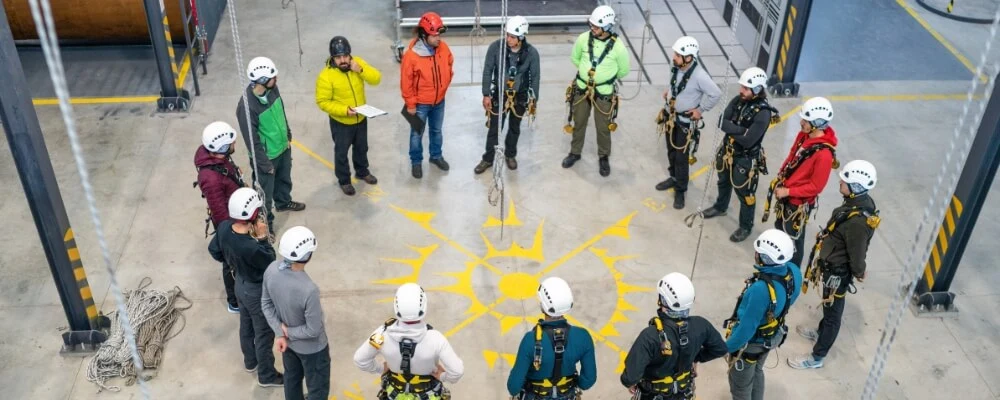
6. Working at Heights
Working at heights is common in several industries and presents unique fall-related risks. It’s essential to discuss the safety measures needed to mitigate these risks. Employees should be trained on correctly using fall protection equipment, such as harnesses, guardrails, and safety nets, and understand the importance of regular equipment inspections. They should also know how to assess their environment for hazards like unstable surfaces or windy conditions.
Moreover, procedures for safely ascending, descending, and working at height should be covered. By emphasizing these precautions, you can significantly reduce the risk of fall-related injuries in the workplace.
7. Drug or Alcohol Abuse on the Job
Drug or alcohol abuse on the job is a serious issue that can severely impact an individual’s health, productivity, and workplace safety . It’s crucial to articulate the company’s policy regarding substance use clearly and strictly, highlighting that impairment at work is unacceptable. Employees should be educated about the detrimental effects of substance abuse on their work performance, personal lives, and health.
Organizations should also provide information on resources such as counseling or rehabilitation programs, offering support to those struggling with addiction and fostering an environment of understanding and assistance rather than judgment or punishment.
8. Workplace Violence
Workplace violence, ranging from threats and verbal abuse to physical assaults, poses significant safety and health risks. Educating employees about recognizing potential signs of workplace violence, including aggressive behavior, verbal threats, or sudden changes in behavior, is critical. Establishing clear protocols for responding to such situations, including immediate reporting mechanisms, can help prevent escalation.
By cultivating an environment of trust and support, employees will feel encouraged to express concerns about potential violence without fear of retribution, contributing to a safer and healthier workplace.
9. Manual Handling
Manual handling, involving lifting, carrying, moving, or otherwise manipulating objects by hand, is a common cause of workplace injuries . Proper training on safe manual handling techniques is essential to prevent these injuries. This includes understanding the principles of safe lifting (such as lifting with the legs, not the back), knowing when to ask for help or use equipment, and how to safely move or carry loads.
Regular refresher courses can help keep this knowledge up-to-date and reinforce the importance of safe manual handling. Companies can significantly reduce the risk of strains, sprains, and other related injuries by equipping employees with these skills.
10. Personal Protective Equipment (PPE)
Personal Protective Equipment (PPE) is a vital safety aspect in many work environments, particularly in healthcare, construction, and manufacturing industries. Proper use of PPE can significantly reduce the risk of injury or exposure to harmful substances.
Employees should be trained on how to use, maintain, and dispose of various types of PPE correctly. This includes understanding which type of PPE is appropriate for different tasks, how to wear it correctly for maximum protection, how to clean and maintain reusable PPE, and how to safely dispose of single-use PPE. Reinforcing these guidelines helps ensure the effectiveness of PPE and promotes a safer working environment.

11. Electrical and Fire Safety
Electrical and fire safety are paramount in virtually all work environments. Employers should discuss necessary precautions to prevent electrical shocks, such as not overloading outlets, keeping liquids away from electrical equipment, and not using equipment with damaged cords. Regular electrical equipment inspection and maintenance are essential to ensure they’re in safe working condition.
Regarding fire safety, employees should be educated on preventative measures like proper waste disposal and avoiding the blockage of fire exits. Additionally, fire safety training should be conducted periodically, ensuring that employees know how to use fire extinguishers, understand evacuation procedures, and know emergency exit locations. This comprehensive approach helps minimize the risk of electrical and fire-related incidents.
12. Ergonomic and Workplace Stress
Ergonomics and workplace stress are critical factors in employee productivity and overall well-being. In discussions about ergonomics, employees should learn how to design their workspace for comfort and efficiency, thus reducing strain and the risk of injury. This could include correct seating posture, optimal placement of computer screens, and usage of ergonomic office equipment.
Alongside this, it’s crucial to manage work-related stress by promoting regular breaks, time management, balanced workloads, and fostering a supportive work environment. A holistic approach addressing physical and mental stressors can significantly improve health outcomes and productivity.
13. Reporting Hazards and Incidents
Promptly reporting hazards and incidents is crucial in maintaining a safe workplace environment. Employees should feel encouraged and empowered to report any safety concerns or incidents without fear of reprisal. This reporting allows for quick corrective action, reducing the likelihood of accidents or injuries.
Companies should have clear, straightforward procedures for such reports, including dedicated reporting lines, online forms, or direct communication with safety officers or supervisors. Regular discussions on this topic ensure that all employees know the reporting process and its significance in workplace safety.
14. Chemical Safety
Chemical safety is vital to many workplaces, including labs, factories, and cleaning services. Employees handling chemicals should be trained to use, store, and dispose of these substances safely to prevent accidents , spills, and potential health hazards. They should understand how to interpret Material Safety Data Sheets (MSDS), which provide detailed information about each chemical’s properties, hazards, protective measures, and safety precautions.
Training should also cover using personal protective equipment when handling chemicals and emergency procedures in case of accidental exposure or spillage. Regularly discussing these procedures helps ensure a safer workplace environment and reduces the risk of chemical-related incidents.
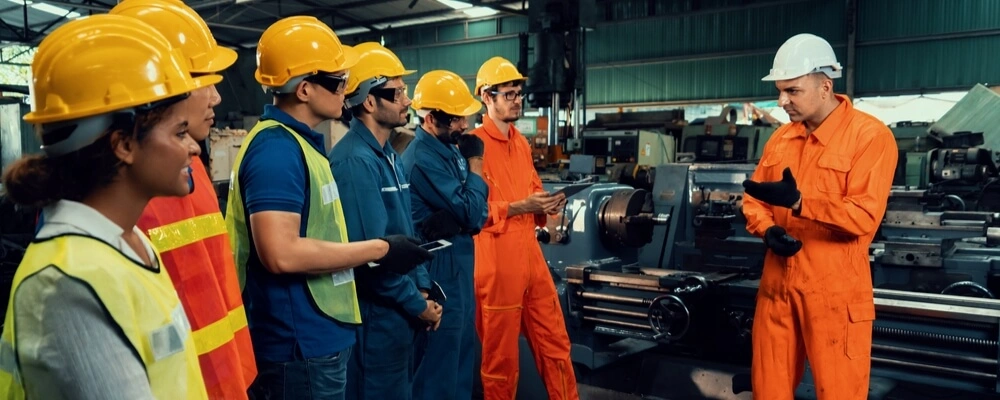
15. First Aid Training
First aid training is essential to workplace safety, equipping employees with the skills to respond quickly and effectively during medical emergencies. Such training can range from basic skills like wound dressing, CPR, and handling of minor injuries to more advanced practices for specific industries. By understanding these first aid techniques, employees can not only help stabilize a situation until professional medical help arrives but could potentially save lives.
It is recommended that these training sessions be conducted regularly to keep the information fresh and up-to-date. Creating a workplace where employees are confident in responding during emergencies promotes safety and readiness.
16. Equipment Safety
Equipment safety is crucial in many industries, from manufacturing and construction to hospitality and healthcare. All machinery or equipment employees should receive comprehensive training on correct usage, safety protocols, and the risks associated with improper use. This training should include preventative measures like regular equipment inspections, maintenance, and reporting faulty machinery immediately.
Ensuring that each employee is competent in handling their equipment, the risk of injuries due to mishandling or malfunctions can be significantly reduced, leading to a safer and more efficient workplace.
17. Mental Health Awareness
Mental health is a vital aspect of overall employee wellness and productivity. Creating an environment where mental health is acknowledged and supported is important. Regular discussions about the significance of mental well-being, signs of common mental health issues, and stress management techniques can help to destigmatize these topics and encourage employees to seek help when needed.
Additionally, companies should provide resources such as counseling services, mental health days, and wellness programs. Ensuring that employees are aware of these resources and feel comfortable using them is critical in supporting mental health in the workplace.
18. Noise Exposure
Noise exposure in the workplace can lead to permanent hearing loss or other hearing complications over time. Discussing ways to mitigate these risks is crucial in environments with high noise levels. This might include operating noisy machinery during specific hours, maintaining equipment to reduce noise, and creating quiet zones for employees. Alongside these measures, personal protective equipment such as earplugs or earmuffs is often necessary.
Employees should understand the correct usage of such protection and its importance in preventing hearing damage. Regular hearing checks can also help monitor employees’ hearing health and detect any issues early.
19. Office Safety
Office safety, though seemingly straightforward, is important in maintaining employee health and productivity. This includes setting up workstations correctly to minimize strain and discomfort—employees should be aware of the appropriate height for desks and screens, the correct positioning of keyboards and mice, and how to adjust chairs for optimal support. Discussing correct posture can help prevent long-term issues like back pain and repetitive strain injuries.
Additionally, the importance of taking regular short breaks should be emphasized, as this can help reduce fatigue and stress on the body. Companies can help ensure their employees remain healthy and productive by maintaining a safe and comfortable office environment.
20. Emergency Evacuation Plans
Emergency evacuation plans are vital to workplace safety designed to ensure quick and orderly evacuation during emergencies such as fires, earthquakes, or chemical spills. Regularly reviewing these procedures informs employees about the quickest and safest exit routes, meeting points, and roles during an evacuation.
Drills should be conducted periodically to practice these procedures and to identify any areas of confusion or inefficiency that need to be addressed. Ensuring all employees are familiar with these plans and can execute them calmly and efficiently in emergencies can significantly enhance safety and reduce potential harm.
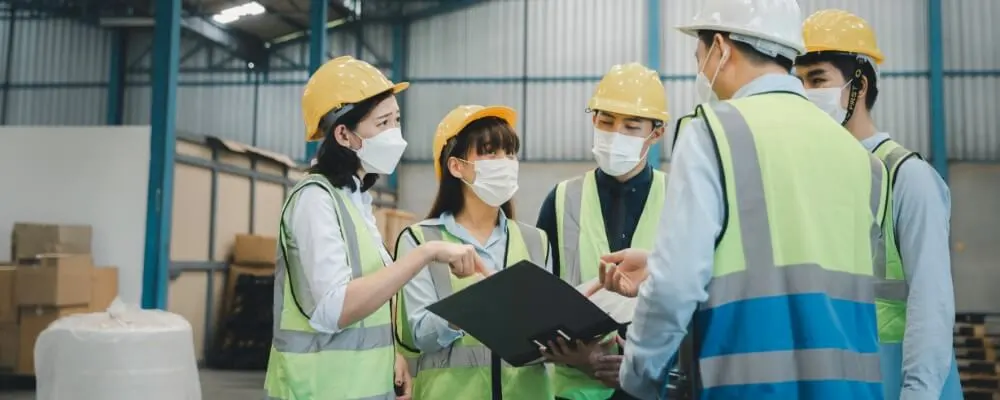
21. Radiation Safety
Radiation safety is a significant concern in workplaces where employees might be exposed to radiation, such as in healthcare facilities, research laboratories, or nuclear power plants. Employees should be trained on the principles of radiation safety, often summarized as time, distance, and shielding – limiting exposure time, maintaining a safe distance from radiation sources, and using appropriate shielding materials.
They should understand the different types of radiation, the potential health effects, and the safety equipment and procedures designed to protect them, such as using dosimeters to monitor exposure and wearing lead aprons when necessary. Regularly revisiting these principles can help ensure employees remain vigilant and well-protected.
22. Fatigue Management
Fatigue management is critical to workplace safety, as tiredness can significantly impair work performance and lead to serious accidents. It’s important to discuss the signs of fatigue, such as persistent tiredness, decreased alertness, slow reaction times, and poor decision-making. Employees should understand the importance of adequate rest and sleep, balanced nutrition, and regular exercise in maintaining energy levels.
Additionally, discuss strategies for managing fatigue, including taking regular breaks, managing workload effectively, and seeking medical advice if persistent fatigue is experienced. By promoting a culture that values rest and recognizes the risks of fatigue, employers can contribute significantly to the overall safety and productivity of the workplace.
23. Safe Use of Power Tools
Safely using power tools is crucial in industries like construction, manufacturing, or woodworking, where these tools are frequently used. Employees should be educated about the proper use, maintenance, and safety precautions associated with each type of power tool they use. This includes understanding the functions and limitations of each tool, wearing appropriate personal protective equipment, checking tools for damage before use, and maintaining them correctly to ensure their safe operation.
Emphasizing that tools should only be used for their intended purposes can help prevent misuse-related accidents. Regular discussions and training on these topics help ensure employees operate power tools safely and competently, reducing the risk of injuries.
24. Biological Hazards
Biological hazards can pose a significant risk to health in certain workplaces, such as healthcare facilities, laboratories, or waste management sites. Employees in these settings should be trained to understand the potential risks of exposure to biological agents like bacteria, viruses, or other biohazardous materials. This includes proper use of personal protective equipment, good hygiene practices, safe handling procedures, and disposal methods for biohazardous waste.
Procedures for exposure incidents, including reporting, first aid, and medical follow-up, should also be explained. Regular discussion can help prevent exposure incidents and maintain a safer working environment.
25. Personal Hygiene
Personal hygiene is crucial in maintaining a healthy and safe working environment, particularly in preventing the spread of infectious diseases. Regular discussions should be held on best practices, such as regular handwashing with soap and water, using hand sanitizers when soap isn’t available, keeping workstations clean, and practicing good respiratory etiquette, like covering mouth and nose when coughing or sneezing.
It’s also important to encourage employees to stay home when feeling unwell to prevent the potential spread of illness. Additional measures like wearing masks or social distancing might be needed in public health crises. Maintaining good personal hygiene benefits everyone and contributes to a healthier working environment.
Prioritizing workplace safety ensures employees’ well-being and fosters a positive work culture and productivity. By discussing the 25 safety topics outlined in this article in your safety meetings, you can create an environment where everyone feels empowered to uphold safety standards.
Remember, creating a safer workplace is a continuous journey that requires regular discussions, ongoing training, and constant vigilance. By investing in these safety talks, you invest in the well-being of your most valuable resource – your employees.
Bilal Bangash
Get More Inspiration & Our Latest News
Stay informed and protected with our exclusive updates delivered right to your inbox.
Welcome to the must-read blog for professionals in the health and safety field. Dive into the universe of health and safety with our enlightening blog crafted for professionals like you.
Quick Links
© Occupational Health and Safety Blog
- +1 (800) 826-0777
- VIRTUAL TOUR
- Mass Notification
- Threat Intelligence
- Employee Safety Monitoring
- Travel Risk Management
- Emergency Preparedness
- Remote Workforce
- Location and Asset Protection
- Business Continuity
- Why AlertMedia
- Who We Serve
- Customer Spotlights
- Resource Library
- Downloads & Guides
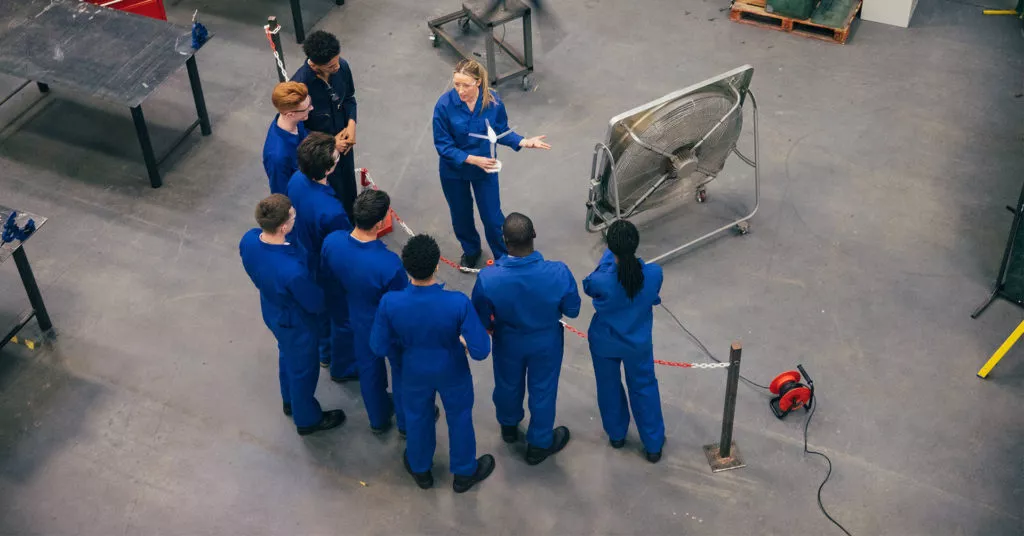
32 Short Safety Talks: Topics & Ideas to Boost Engagement
Leaving conversations about safety to quarterly meetings and occasional safety training means safety skills and awareness atrophy over time. Want a way to refresh critical concepts without losing everyone’s attention? We have you covered with safety-in-the-workplace topics.
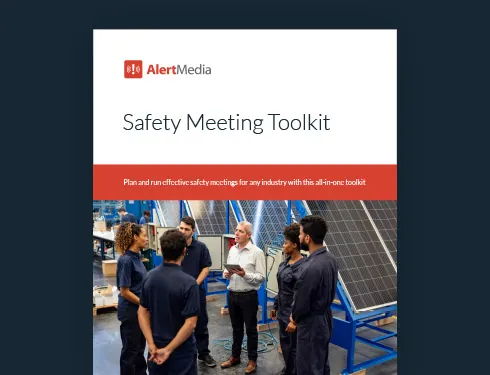
- What Are Safety Talks?
- How to Make Safety Talks More Engaging
32 Safety Talk Topics
No matter what kind of work you do, it’s easy to become complacent, especially if you’ve spent most of your days performing familiar tasks on repeat. It can be tempting to cut corners and forego best practices in the interest of time, productivity, and effort. If you find yourself going down this path, be wary because skipping steps and ignoring rules could result in an avoidable emergency.
One way to prevent these lapses and complacency among your team is to use short safety talks to remind everyone of proper procedures and prepare them for new hazards and variables they’ll encounter during the workday.
Safety Meeting Toolkit
What are safety talks in the workplace.
Workplace safety talks are short, digestible, pre-work meetings about a particular safety topic that informs the work people are doing that day. These talks are most effective when kept short, focused, and memorable so workers can easily apply the advice right away and recall it over the long term.
Sometimes known as “safety toolbox talks,” “safety briefings,” or “safety moments,” safety talks can cover any number of topics as long as they’re related to worker and workplace safety.
How to Make Short Safety Talks Engaging and Effective
Safety leaders tasked with devising short safety talks tend to focus entirely on the talk’s content, ignoring its form. They may even forget that it’s their responsibility to engage people so they’ll absorb the information and be ready to put it to use.
Consider ways to maintain safety engagement and interest in your content. This is partly about what not to do: For example, an uber-professional tone could work against you. Your safety talks won’t do much good if your audience falls asleep two minutes in. It’s also about active strategies to get people involved in the discussion and to get them to buy into the significance of their everyday safety efforts.
Ask questions
One of the main reasons people ignore meetings is that they believe it’s a waste of time because they won’t learn anything new. This can become a self-fulfilling prophecy; if they don’t think they’re going to learn anything new, they’re going to check out and miss the important information.
Counter this tendency by asking questions. When people realize they have an opportunity to speak their minds, they’re much more likely to become personally invested in the topic at hand. These questions shouldn’t put people in the hot seat but, rather, allow your frontline workers to give feedback.
Inject some humanity
When talking about safety practices, many speakers tend to become very formal and clinical in their language because they want to convey the seriousness of the topic and avoid distractions. Unfortunately, this can lead to disengagement, making your presentation ineffective.
Bring some color to these talks with visual aids, humor, and analogies, keeping your people awake and receptive to the safety talk topic.
Reward engagement
It might sound diminutive, but who doesn’t like a mini candy bar? Try tossing some rewards out for those who engage in the talks by asking poignant questions, helping others understand, or adding their own thoughts. Gift cards or other incentives work equally well.
Watch this video to learn the fundamentals of compelling safety talks, discover new topic ideas, and get facilitation tips.
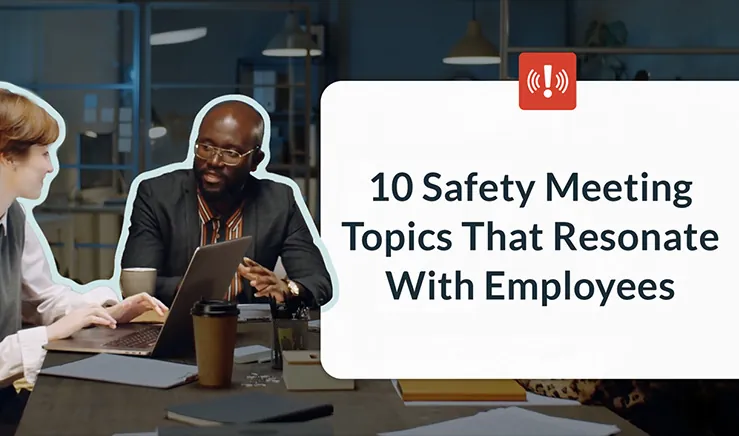
Pro Tip: Keep a running list of safety-in-the-workplace topics. With it, you can not only prepare for upcoming safety talks but also integrate those meeting topics with broader emergency planning and preparedness efforts and involve various stakeholders. You can use the Topics Sheet from the Safety Meeting Toolkit to keep track of the topics you’ve gone through and what to cover next.
The safety messages you incorporate in your safety talks and training sessions should be inspired by your work objectives and conditions. However, if you’re looking for some ideas to get you started, here are our suggestions.
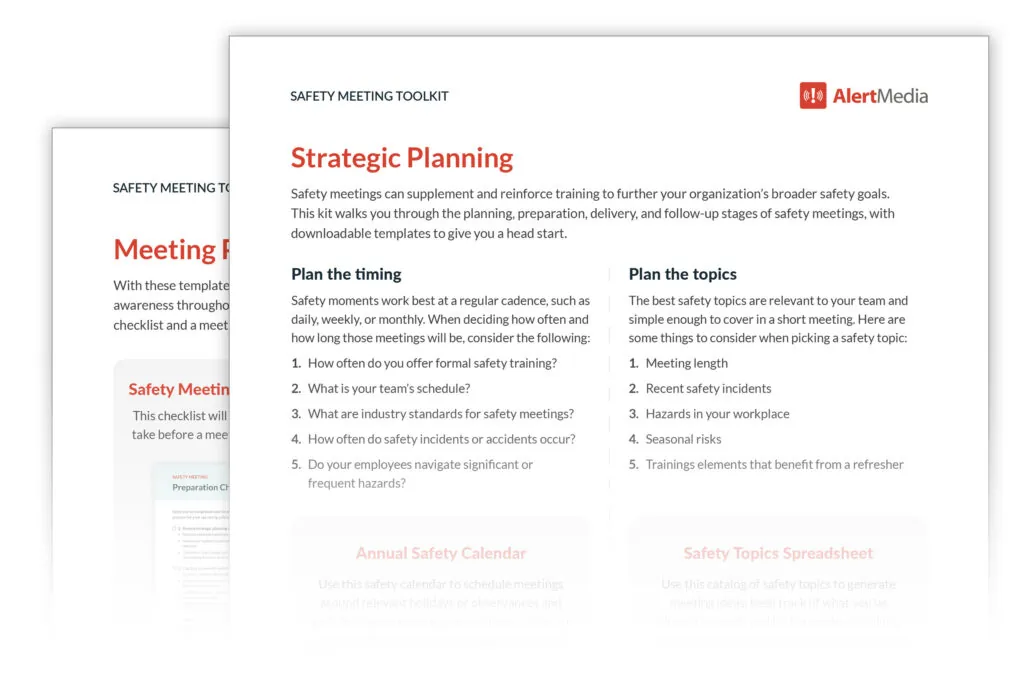
Find more topic suggestions and talking points in the Safety Meeting Toolkit .
External Hazards
“The world is changing very, very fast…to be as flexible as possible–that’s what we’re doing every day.”
— Helmut Spahn , Director of Safety, FIFA
1. Electrical safety
Improper electrical distribution is a deadly hazard in the workplace. Electrocutions are one of the most common causes of injuries and fatalities on construction sites , and daisy-chained extension cords and power strips are a disturbingly common fire safety hazard. Promote fire prevention and avert workplace injuries by inspiring everyday accountability for safe electrical setup and operation.
2. Hot work safety
Heat stress prevention is key in many fields, especially those that require outdoor work during the summer months. It’s so important that OSHA is working on official regulations to require heat safety measures from many employers.
3. Cold work safety
Cold weather can be deadly when preparedness efforts fall short. Share cold-weather safety tips with your team before a day of working in the cold, and set them up with a buddy system so all workers have someone who can look after them.
4. Defensive driving
Workers who commute or those who drive for work can be faced with unpredictable dangers on the road. It’s your duty to provide for their safety while they’re on the road. Defensive driving skills are one of the best ways to make sure your team members get to their destinations safely.
5. Anti-phishing awareness
Phishing attacks—where bad actors send fake messages claiming to be someone else to gain access to restricted systems or resources—have increased year over year . These aren’t “hacks” in the traditional sense. They rely on basic social manipulation, not crafty coding or software vulnerabilities. Reminding workers how to spot phishing attacks can save your organization a lot of time, money, and trouble.
6. Active shooter awareness
While active shooter events are rare, they are becoming a greater strain on Americans’ mental health. Hold a safety meeting to go over your active shooter response plan , and reassure employees you’re looking out for their safety.
Individual Safety
“Safety is way more than compliance…it’s a moral imperative that we send people home to their loved ones.”
— Scott Gerard , VP of Environmental Health and Safety at Moss Construction
7. Personal protective equipment (PPE) review
Just as flight attendants remind passengers of the proper use of seatbelts, life jackets, and oxygen masks before every flight, you need to remind workers of the proper use of their PPE and safety gear so they’re more confident relying on it during an emergency. Common PPE—hard hats, safety glasses, respirators, fall protection harnesses, and high-visibility vests—could be the things that prevent serious injuries or death.
8. Particulate matter safety
Depending on the job site, small bits of liquid or solid material can be suspended in the air, which can wreak havoc on human bodies if inhaled. Some of these materials, like asbestos, are particularly dangerous. Use a safety topic of the day to remind everyone about signs of hazardous substance exposure and why PPE is important in these situations.
9. Tool safety
Some power tools and hand tools, from nail guns to chainsaws, have a natural level of risk associated with their use. You can gather your team at the beginning of a workday to remind them of the safety protocols for a particular tool and reduce those risks.
10. Personal health
An employee’s health is usually impacted by their private life more than it is by their work environment. Taking time to encourage healthy sleep and exercise habits, as well as attending annual medical check-ups, can help keep your workforce in peak condition.
11. Office ergonomics
Office workers might assume they don’t face any workplace hazards, but ergonomics should not be underestimated. Poor posture, inconveniently sized equipment, and other ergonomic problems can lead to carpal tunnel syndrome, joint pain, and other safety concerns. The work should fit the worker, not the other way around. Remember to include remote workers in these talks as well.
12. Proper lifting techniques
We’ve all been there—we go to pick something up and underestimate its weight. When workers bend at the waist to lift, they risk seriously injuring their backs. Prevent these avoidable injuries by teaching proper lifting techniques as a quick safety topic.
13. Mental health & well-being
Mental health and well-being have increasingly become areas of focus across demographics, and this holds true in the workplace . Worsened by the isolation, loneliness, and despair many felt during the height of the COVID pandemic, people’s mental health is at serious risk. Show your employees you care and are there to offer resources and support.
14. Hearing protection
Exposure to noise levels above 85 decibels (roughly the volume of an electric blender) can cause permanent damage to workers’ hearing. And while OSHA requires organizations to provide hearing protection equipment, a safety talk about why they’re necessary and how to use them properly ensures workers are prepared to prevent injuries.
15. Substance abuse
Substance abuse has increased in recent years. If someone is under the influence on the job, the likelihood of an accident skyrockets. Show employees how to recognize signs that a coworker is struggling, and offer treatment and support resources to those dealing with drug and alcohol use disorders.
16. Hydration
No matter what kind of work you do, no matter where you do it, there’s always one thing your people absolutely need: water. Make sure everyone knows where they can find cool water and that they have the right (and the responsibility) to take regular breaks for water.
17. First aid refresher
First aid training is too detailed and intensive to perform during a 5-minute safety talk, but those few minutes are enough to fortify first aid skills among your employees. Potential areas of focus include a reminder of where all first aid equipment is located, the signs of a stroke, or an overview of the proper CPR compression technique.
Safety Administration
“Part of being an effective emergency manager…is helping [workers] understand why it’s important to plan.”
— Jeffrey Trask , Risk Manager at ISO New England
18. Communication review
Even if you have the best emergency notification system , good message templates, and an awesome reporting workflow, your hazard communication efforts will fall flat if employees aren’t reading the messages. Take some time to remind everyone how these notifications work, where they come from, and what to expect. You can also confirm all employees’ contact information as a follow-up action item.
You can use the Follow-Up template from the Safety Meetings Toolkit to communicate after your safety talks.
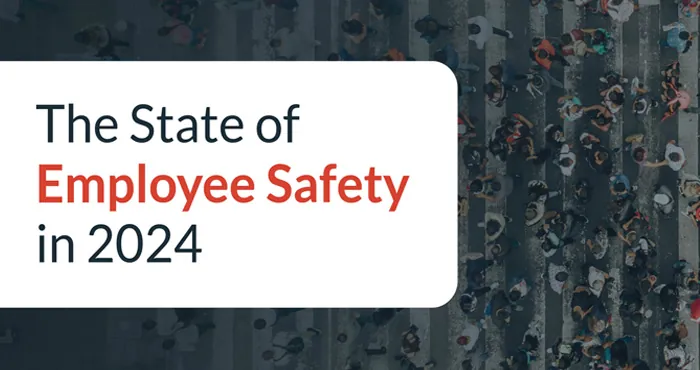
19. Accident reporting
While you can do a lot to make accidents less common, it’s very difficult to eliminate them entirely. While you work toward that goal, consider a short safety talk to review standards, rigorous accident reporting procedures, and after-action reports. These will help prevent similar accidents or near misses in the future.
20. Importance of work stoppages
Some emergencies are made much worse by the “bystander effect.” When a worker feels that they don’t have the authority to stop an unsafe activity, they likely won’t step in when something goes wrong. They might instead opt to wait for a supervisor to make the call—but during an emergency, seconds matter. Hold a meeting to make sure everyone knows that they are within their right to stop any dangerous work and will not be penalized for doing so.
21. Safety culture
Your organization’s safety culture is the aggregate of attitudes, behaviors, and practices regarding safety. It’s key to developing a safe, productive, and caring workplace, but it can only be accomplished with continuous effort. Morning safety talks can keep up your momentum in prioritizing safety first.
22. Workplace access protocol
Who’s allowed on the work site? Who isn’t? What about clients, vendors, and guests? Take a moment to remind your team about proper access control, such as not holding the door open.
23. Labeling potential hazards
Labels for potential hazards like slippery floors or unexpected steps can go a long way in keeping everyone aware and decreasing slip, trip, and fall accidents. Some workplaces may also have dangerous chemicals or zones that are unsafe to enter when equipment is turned on, and warning labels can promote situational awareness.
General Safety
“If workers aren’t following specific protocols, very drastic things can happen not only to them but to their coworkers.”
— Diana Warden , Director of Safety and Security at the Dallas Zoo
24. Situational awareness
No matter the environment and type of work, situational awareness is perhaps the single most significant habit that can keep employees safe. Hold a short safety talk to gauge how situationally aware your employees are. This evaluation will help you plan for more in-depth training to guide them in increasing awareness of risks they may face.
25. Ladder safety
There’s a reason ladders are associated with bad luck: They’re a deceptively deadly tool we frequently rely on. Proper ladder setup, use, and oversight can avoid painful and costly mistakes.
26. Forklift safety
Working with heavy machinery, including forklifts, can be dangerous without the proper training. Safety talks about safe forklift driving and handling are critical for those working with or even near these tools.
27. Workplace violence
Workplace violence is increasingly common, particularly in service industries and healthcare. Talk with your employees about the types of workplace violence , warning signs, and prevention steps they can take, including how to identify and report potential violence through an open, non-punitive channel.
28. Emergency exits
Every indoor workspace should have clearly marked emergency exits as part of a fire evacuation plan . That plan requires you to regularly review these emergency exit routes with your team, especially if you’re working in a new, unfamiliar location or in case one or more exits become blocked in an emergency.
29. Heavy vehicle safety
Heavy vehicles—such as forklifts, trucks, cranes, and other heavy-duty machines—have the potential to cause damage to people and property. Make sure all workers are aware of the dangers and how to keep themselves and others out of harm’s way.
30. Fire extinguisher use
Portable fire extinguishers are ubiquitous and extremely effective at protecting people and property from fire damage but only if they’re used properly. When holding a short fire safety talk about correct fire extinguisher use, try turning it into a game to see who has the best fire extinguisher aim.
31. Confined space awareness
Some confined spaces have respiratory hazards, engulfment hazards, electrical dangers, or any number of factors that make them more dangerous than your average crawlspace. These are often restricted by posted signage. Make sure your team knows who is and isn’t permitted in these spaces and what the signage looks like. Trenching work, pipework, and other assignments are associated with these risks.
32. Carbon monoxide safety
Dubbed the “silent killer” because it’s undetectable by humans, carbon monoxide is deadly and you must monitor for it, especially in the presence of flammable gasses, exhaust, and heaters. Ensure your employees know the signs of carbon monoxide poisoning and how to double-check that CO monitors are working properly.
Every Day Can Be a Safe Day
Carving out small chunks of time to regularly review digestible safety topics goes far beyond just preparing your employees for individual hazards. By making these short safety talks a familiar fixture of everyone’s days, you ingrain the idea that safety is always the number one priority. But it’s not safe for safety’s sake—it’s expressly to protect your business, its operations, and its people so everyone can work confidently, without disruptions.
More Articles You May Be Interested In
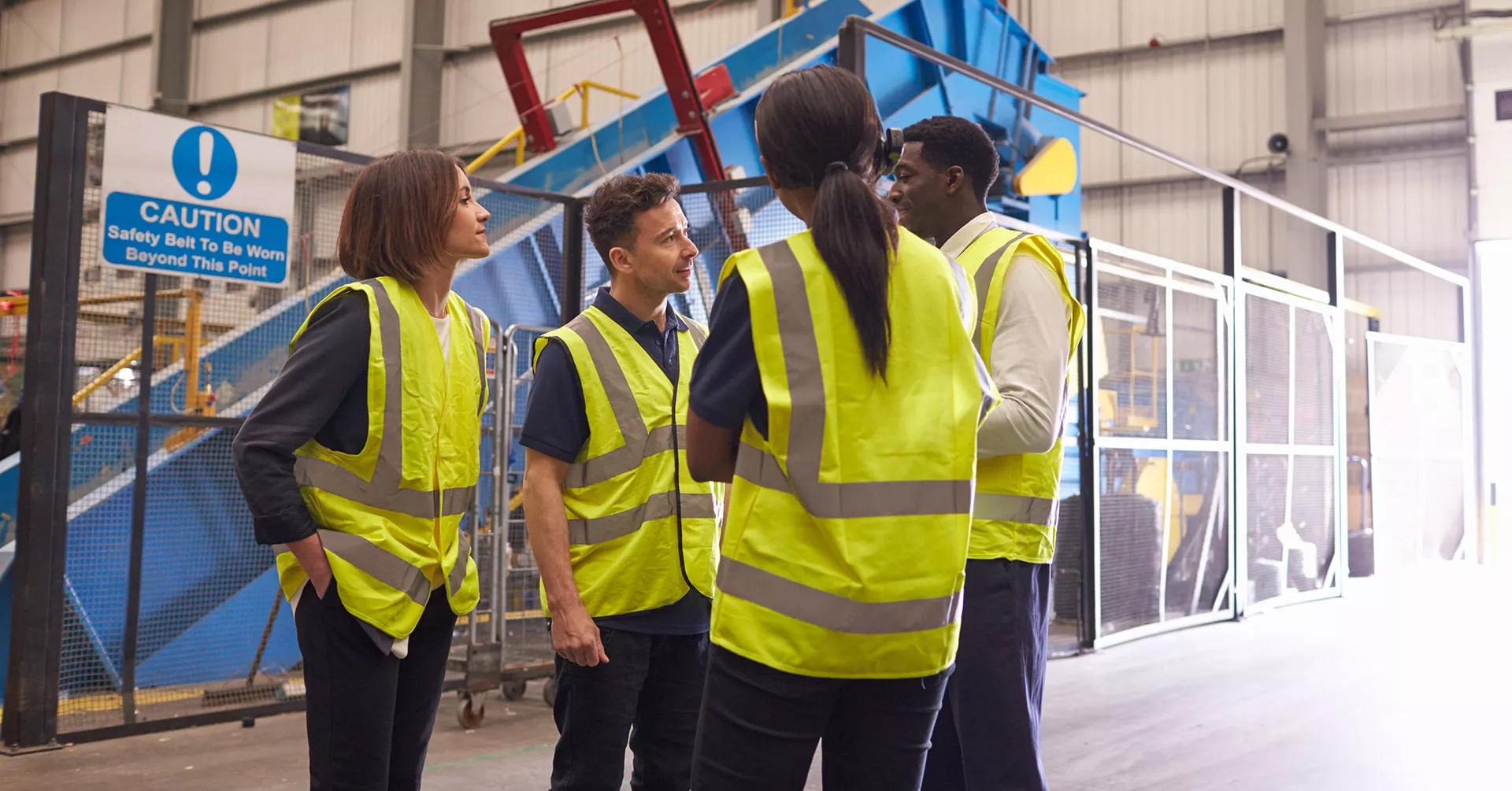
Please complete the form below to receive this resource.
Check Your Inbox!
The document you requested has been sent to your provided email address.
Cookies are required to play this video.
Click the blue shield icon on the bottom left of your screen to edit your cookie preferences.

Free Safety Talks to Print for Your Next Safety Meeting
Looking for safety talk topics to use at work? Scroll down to browse the list of 250+ completely free safety talks below! Print them off to use for your next safety meeting or safety moment with your employees. Use the links below to segment the talks by the most relevant topic category to easily find what you are looking for.

Members have access to over 320+ additional toolbox talks that are not found on this free site. There are also PowerPoint presentations with quizzes, 80 Spanish safety talks, and hand-picked weekly topic ideas. Additional members-only content is added every month!
Click the image of the safety talk to the left to download 1 of the over 550+ ad-free talks that are available for Members!
Save time and money from having to create your own resources. Instead, use that time to continue furthering your safety program.
Separate Talks by Category: BEHAVIORAL | CONSTRUCTION INDUSTRY | GENERAL INDUSTRY | OFFICE | MOTOR VEHICLE | SPANISH
Free Safety Toolbox Talk Topics Complete List
- * Advice for Using These Toolbox Talks *
- Achieving Safety Goals
- Alcohol Use
- Amputations
- Annual Checkup
- Asbestos Dangers
- Attitude and Safety: Fostering Positive Attitude at Work
- Auto Accident Procedures
- Automated External Defibrillators
- Back Injuries and Prevention
- Backing Up Hazards
- Battery Handling
- Battling Complacency
- Bees and Wasps
- Before a Work Task Begins
- Being Client-focused (Construction Industry)
- Being Observant
- Being Respectful to Coworkers
- Benzene Dangers in the Workplace
- Bloodborne Pathogens
- Burn Hazards and Injury Prevention
- Burn Severity
- Carbon Monoxide Safety
- Carcinogens in the Workplace
- Chainsaw General Safety
- Choices at Home and Safety on the Job
- Clothing and Safety
- Cold Stress Hazards
- Common Cold
- Common Issues with Fire Extinguishers
- Communicating Issues
- Communication and Safety
- Communication Tools and Safety
- Concrete Burns
- Concrete Work
- Continually Learning
- Conveyor Belt General Safety
- Costs of Drugs on the Job
- Dangers of Excessive Sitting
- Dealing with Hazards
- Dealing with Stress from Home
- Defensive Driving
- Diesel Exhaust Dangers and Safeguards
- Distracted Driving (Cellphone Use)
- Distracted While Walking
- Distractions Created by Smartphones When Not in Use
- Dog Attacks
- Doing Work Tasks Wrong the First Time
- Driving Safely Where Deer Are Present
- Dropped Objects on the Job
- Drowsy Driving
- Drunk Driving
- Dump Truck Operation
- Dump Truck Overturns
- Dust Hazards in Construction
- Easy Way Instead of the Right Way
- Eating Habits
- Electrical Injuries
- Electrical Safety
- Elimination of Hazards
- Embracing Change in the Workplace
- Emergency Exits
- Energy Drink Dangers
- Everyone is Responsible for the Culture
- Excavation Safety
- Excavator Quick Coupler Device Safety
- Eye Damage Due to Sunlight
- Eye Injuries and Prevention
- Fall Protection
- Falls in the Construction Industry
- Falls on the Same Level
- Fatal Four Hazards (Construction)
- Fatigue on the Job
- Fatigue on the Roadways
- Filter Pot Sock Filter Changeout
- Fire Extinguishers Use and Inspection
- Fire Safety at Home
- Fire Watch General Safety
- Firework Safety and Injury Prevention
- First Aid Preparedness
- First Day Back to Work
- Five Common Contributing Factors
- Fixed Objects (Motor Vehicle Safety)
- Fixed Open Blade Knives
- Food Allergies
- Forklift Fatalities and Injuries
- Four Focus Items for Work Area Inspections
- Front End Loader Safety
- Gasoline Safety
- Glycol Reclamation
- Good Enough Mindset
- Ground Personnel and Mobile Equipment
- Habits and Safety
- Hand Safety and Injury Prevention Safety Talk
- Hand Tool Inspections
- Hazardous Chemicals- Four Routes of Entry
- HDPE Pipe Welding
- Health is Everything
- Heart Attacks
- Heat Stress
- Heat Stroke
- Heavy Equipment (Four Other Hazards)
- Heavy Equipment (Two Significant Hazards)
- Heavy Equipment Operation
- Helping Out
- Hierarchy of Controls
- High Wind Dangers (Construction)
- Horseplay on the Job
- Hose Parting Pneumatic Testing
- Housekeeping in the Construction Industry
- How Observant Are You?
- How to Calculate Your Company’s TRIR (Total Recordable Incident Rate)
- How We React to Our World
- How What We Do at Home Affects Work
- Human Performance
- Hydration: The Importance of Water
- Hydrogen Sulfide
- Importance of Mentoring
- Importance of Organized Laydown Yards
- Incident Report Writing: A Comprehensive Guide
- Insect Sting Allergies
- Instant Gratification and Safety
- Involve the Right Person
- It Was a Matter of Time
- It Won’t Happen to Me
- Know Your Limits at Work
- Knowing What to do in an Emergency
- Lack of Time
- Ladder Safety
- Lawn Mower Safety
- Lead Paint Dangers and Safety
- Learning From Past Incidents
- Learning the Hard Way
- Leave Yourself an Out
- Lifting and Rigging
- Lightning Safety at Work and Home
- Line of Fire Hazards
- Lube Oil Flushing
- Lyme Disease
- Machine Guarding
- Manual Handling Injury Prevention
- Material Recovery Facilities General Safety
- Mechanical Issue-Related Crashes
- Motor Vehicle Safety
- Motor Vehicle Safety (Loose Cargo)
- Muddy Work Areas
- New Employees on the Job
- New Equipment
- Nine Basic Construction Safety Rules
- Noise at Work and Home
- Noise-Induced Hearing Loss
- Not a Big Deal Until it is
- Not My Problem
- Occupational-related Cancer
- Office Safety
- One Billion Dollars Spent on Injuries a Week
- One Decision
- One Safeguard Doesn’t Make it Safe
- Opioid Abuse
- Organization of Work Areas
- Orthostatic Intolerance
- Pinch Points and Hand Injuries
- Playing the Lottery and Workplace Injuries
- Pressure to Get Work Done
- Pressure Washing
- Preventing Equipment Damage Incidents in Construction
- Proactive Versus Reactive Safety Approach
- Questions to Ask Before a Work Task
- Rabies in the US
- Radio Communication on the Job
- Rationalizing Unsafe Choices
- Ready For Work
- Recognized Versus Unrecognized Hazards
- Recordable Injuries – Why Employees Should Care
- Relying on Memory
- Report All Injuries
- Respirator Donning, Doffing, and Seal Checks
- Road Rage (Motor Vehicle Safety)
- S.O.R.T Tool
- Safety Awareness: Being Present in the Moment
- Safety Can Be Redundant
- Safety Glasses
- Safety Related Paperwork
- Seatbelt Use and Safety
- Securing a Construction Site
- Selective Attention at Work
- Seven Basic General Industry Safety Rules
- Severity and Frequency
- Shift Work Dangers
- Shortcuts are a Choice
- Shoveling Snow
- Silica Dust Dangers and Safety Measures
- Skid Steer Safety
- Skin Cancer Due to Sun Exposure
- Sling Inspections
- Slip Hazards and Safety
- Slips, Trips, and Falls
- Smoking and Your Health
- Snakes in the Workplace
- Spill Prevention
- Spotter Safety at Work
- Stopping Work
- Stretching Pros and Cons
- Strokes- Signs and Emergency Response
- Struck-by Incidents (Construction)
- Success Through Reaching Potential
- Surveying (Construction)
- Table Saw General Safety
- Take Safety Home
- Taking Action to Work Safe
- Taking Ownership of Safety
- Taking Safety For Granted
- Taking Shortcuts
- Task Planning
- The “WHY” for “WHAT” Needs Done
- The Little Things
- The Negative Side of Quick Reactions
- The Ripple Effect of Safety
- Theft from a Construction Site
- Think of the Next Person
- Three Self-Centered Reasons to Work Safely
- Three Types of Poor Housekeeping Hazards
- Three Way Communication
- Top Five Reasons to Work Safely Today
- Tornado Safety
- Train Safety
- Trip Injuries and Prevention
- Truck Driving – Hazards On and Off the Road
- Two Types of Workplace Stress
- Types of Fire Extinguishers
- Underground Utility Strikes
- Unloading Trailers (Construction)
- Unsafe Acts
- Unsafe Conditions in the Workplace
- Utility Vehicle Safety at Home and Work
- Vehicle Inspections
- Verbal Communication and Workplace Safety
- Verifying Safeguards
- Weakest Link on Your Team
- Weed Wacker Safety
- West Nile Virus
- What Can Hurt Me Today?
- What is Your “Why”
- What Kind of Influence are You?
- Which Safeguard Makes the Difference?
- Why We All Should Care
- Wildlife in the Workplace
- Wind Chill Index
- Winter Weather
- Winter Weather Driving
- Work Area Best Practices
- Working Alongside Subcontractors
- Working From Home
- Workplace Inspections
- Workplace Shootings
- Workplace Suicides
- Workplace Violence
- Young Drivers and Motor Vehicle Accidents
- Zero Injuries in the Workplace
What Are Workplace Safety Talks?
Safety talks are short safety messages for the members of a work crew prior to work beginning. These talks can be as short as a few minutes or longer than 20 minutes. On average, they are in the range of 5 or 10 minutes long in duration at most companies when conducted often. The talks can cover a range of topics or just a single focal point.
Below are answers to some other common questions individuals may have about conducting these types of talks for their work crews.
$MMT = window.$MMT || {}; $MMT.cmd = $MMT.cmd || [];$MMT.cmd.push(function(){ $MMT.display.slots.push(["57a88d0a-5ddd-4a6a-93de-ba5c49768835"]); })
What are other names for these meetings.
There are many names for safety talks. Some of the more common names are safety toolbox talks, toolbox talks, safety moments, safety briefings, safety pep talks, and tailgate meetings. For the most part, many of these names represent the same thing. However, there can be slight differences between companies or industries.
These meetings, no matter what they are called, are the safety message of the day for a work crew prior to the start of the day.
Providing a Safety Moment of the Day
When done correctly, these talks can have a profound effect on the overall safety program at a workplace. Companies that spend time holding these meetings are less likely to have injuries compared to a company that does not hold them on a regular basis.
Conducting meetings often is an effective way to deliver relevant and timely safety messages to an entire work crew. The time spent conducting these talks also goes a long way toward reinforcing prior training efforts.
Even just holding a 5-minute meeting every day equates to a massive amount of knowledge for your workforce over a year’s time. To be exact- it results in over 20 hours of education per employee a year! (5 minutes X 5 workdays per week X 50 work weeks= 1250 minutes… 1250 minutes/60 minutes per hour= 20.8 hours of education) Imagine the difference that education can make if you make the most out of every talk!
What Topics Should You Cover for These Safety Talks?
The topic or topics you should cover for the next safety toolbox talk will vary greatly from what topic(s) another company should be discussing. Some general questions you can ask yourself to narrow in on some topics:
- What training needs to be reinforced?
- What problems have we been having lately?
- What are common injuries in this line of work?
- What have our near misses been a result of?
- What trends are occurring in the workplace or in our industry?
There are many other questions or guidelines you can use to determine what topics or topics you should cover. Keep topics useful, relevant, and timely.
Where Can I Find Free Safety Topics Online in 2023?
This site has one of the largest libraries of free topics found online today. That being said, there are also a number of great resources online to find topics for your next safety meeting. One of our favorite resources for topics is on OSHA’s website. They have a page called Safety and Health Topics that has a large list of high-quality topics.
Some other high-quality and reputable sources for toolbox talks or materials to support talks:
- Mine Health and Safety Administration
- Center for Disease Control
- National Institute for Occupational Safety and Health
- Bureau of Labor Statistics
Who Should Deliver a Safety Talk?
The person who is directing the work should be the one responsible for conducting or leading the safety talk. The responsibility at many companies, however, falls onto the safety officer or EHS manager instead. The reason for having the individual who is directing the work lead the talk is to show support for the message and efforts to work safely.
If it is constantly the EHS department’s responsibility to present, then employees can be led to believe that the frontline supervisors or managers do not truly support safety. If the workers’ supervisors or managers are not participating in the safety efforts, why should they?
The EHS department should instead serve more of an advisory role to the supervisor conducting the talk. They can provide the supervisor with topics, materials, or information for the talk, as well as chime in as needed to add value.
Do not be afraid to offer employees the chance to present at a meeting. While most employees would never choose to present a topic, you may be surprised to find that many would if given the chance.
How Often Should You Conduct Safety Talks?
There is no short and dry answer to how often your company should be conducting these talks. Some companies do multiple talks daily, and other companies may only do them monthly. A monthly schedule is probably way too sparingly for most companies, and two talks a day may be too often for others.
Companies often settle on conducting daily or weekly talks. At many companies, daily safety meetings prior to work beginning is an appropriate practice. Holding meetings that often may not make sense for all operations, however.
As mentioned earlier, these talks do not have to be extremely long. A lot of value can be added in a short amount of time if the talks are completed often. Employees are more likely to take more away from these talks if they are shorter in duration but are more frequent compared to longer meetings that occur infrequently.
Where Should Safety Talks Be Conducted?
These talks should be held in a place where employees are comfortable and can focus. Meeting rooms or break rooms are common areas where companies choose to hold their safety meetings. Another setting that can be even more effective is the work area(s) themselves.
This should only be done if the work area is comfortable, safe, and convenient for all involved in the talk. Conducting the talk in the work area itself can help employees visualize the information being conveyed, as well as allow the presenter to point out specific examples of what they are discussing.
If holding it in the work area is not an option, pictures or maps of the worksite can be great tools so that employees can visualize what is being said.
What Else Can You Do to Have a Better Safety Meeting or Safety Moment?
There are many things you can do to hold a better meeting. Below are a few quick tips that have not already been mentioned in this post:
- Prepare ahead of time.
- Keep topics relevant and timely to the audience.
- Only take the time necessary to cover the topic; do not drag it out.
- Do not read the talk word for word from the paper.
- Get the audience involved by asking for stories or examples relating to the topic.
- Use visual aids as needed to help get your message across.
- Have fun- don’t take yourself so seriously!
For more tips, check out this post on this site that outlines 10 tips for a better toolbox talk .
Does OSHA Require Safety Toolbox Talks?
While OSHA does not specifically require a company to hold safety talks or toolbox talks in any of their standards, doing so can play a part in helping to ensure compliance with some standards. For example, OSHA requires that employers make employees aware of the hazards of the work that they do and how to eliminate them.
One specific example of this is found in the construction standard under 1926.21(b)(2), where OSHA states: “The employer shall instruct each employee in the recognition and avoidance of unsafe conditions and the regulations applicable to his work environment to control or eliminate any hazards or other exposure to illness or injury.”
While training will be a large part of ensuring compliance with this specific regulation, safety toolbox talks are also a way to help to ensure compliance. These talks need to have the correct documentation to do so.
How Should You Document Safety Toolbox Talks?
Without documenting these efforts, there is no actual proof they were done. Meaning there is nothing to show OSHA or someone in your company in response to whether or not you were educating your employees on the hazards involved in their work. A lack of documentation can be problematic.
Every time a talk is conducted, a sign-in sheet should be completed by the presenter and signed by everyone present for the meeting. Some guidelines for documentation:
- Include the date and time.
- Include the presenter(s) name(s).
- Have everyone sign the sheet.
- Be detailed about what topics were discussed.
- Attach any materials used for the talk to the sign-in sheet.
- File documentation in chronological order so they can be easily found to be reviewed if needed.
The answers to the who, what, when, why, and how of safety talks can be as long of a list as the possible topics you could cover in your next meeting. The bottom line is your company should be conducting these talks on a regular basis as well as giving thought on how to continually improve on giving them. Use some of the insight here and tailor it to your company’s needs.
Consider checking out the Members Area of the site. There are plenty of other safety topics covered in there (with additional content added each month) if you find yourself not finding what you need in all of the free content offered on this site!


Researched by Consultants from Top-Tier Management Companies

Powerpoint Templates
Icon Bundle
Kpi Dashboard
Professional
Business Plans
Swot Analysis
Gantt Chart
Business Proposal
Marketing Plan
Project Management
Business Case
Business Model
Cyber Security
Business PPT
Digital Marketing
Digital Transformation
Human Resources
Product Management
Artificial Intelligence
Company Profile
Acknowledgement PPT
PPT Presentation
Reports Brochures
One Page Pitch
Interview PPT
All Categories
[Updated 2023] Top 15 PowerPoint Templates to Improve Work Safety
![top 10 safety presentations [Updated 2023] Top 15 PowerPoint Templates to Improve Work Safety](https://www.slideteam.net/wp/wp-content/uploads/2021/03/06_1013x441-1011x441.png)
Kritika Saini
1974: The Flixborough disaster, UK’s worst industrial accident. The explosion at the chemical plant killed 28 workers in North Lincolnshire. Almost all the buildings in the neighborhood flattened, further injuring 36 people due to the blast. Multiple investigations exposed that the plant was hastily executed with certain modifications that forged the leak of liquid from one of the plant’s reactors. This led to the creation of flammable hydrocarbons that eventually exploded.
1984 : Bhopal gas tragedy, one of the worst industrial accidents in India. Due to the negligence of 7 employees, more than 5 lakh people were exposed to the lethal methyl isocyanate. About 3,787 people died the same night, and further 8,000 people passed away as a result of the exposure subsequently.
2013: West Fertilizer Company explosion. A routine fire in Texas turned into a local disaster when the fertilizer stored on the site exploded. 12 firefighters and 3 civilians were killed, a majority of them were trying to bring the flare under control. Further, 160 people were injured and around 150 buildings collapsed due to the blast. Later, an investigation revealed that the company had been illegally storing 55 tons of ammonium nitrate on-site, along with a further 55 tons of anhydrous ammonia.
Whether as a result of the disasters mentioned above or on an individual basis, workplace accidents have the potential to alter ordinary people’s lives. An estimate of 2 million men and women die every year due to work-related accidents and diseases. Thus, the spotlight is on the importance of safer design and construction of workplaces; maintenance of site safety; dangers posed to public members, and adherence to legal guidelines for secure storage of dangerous materials.
No business wants their employees to get hurt on the job. Therefore, employers are obliged to provide a safe working environment for their workers. But for those of you who haven’t dealt with safety, let us first understand its meaning.
The gist of work safety
Work safety is the concept that business organizations must implement to recognize hazards in the workplace. It refers to the working environment at a company encompassing the factors that impact all employees’ safety, health, and well-being.
Despite the number of safety guidelines you set in place, it will be of no use if your employees are not aware and invested in following them. Therefore, to help you create a successful safety program, we are sharing five security tips. We have also included the top 15 meticulous work safety templates that can be used for raising awareness on safety protocols among employees.
1. Invest in training
When it comes to workplace safety, there is no better solution than training. It will help you create protocols and ask your workforce to follow them to the letter. Provide your employees with all the necessary information and measures to stay safe. In fact, you can also use the online platform for providing training to avoid any wastage of time. Share the updated training courses with your employees using these well-structured template designs.
Template 1
Safety in the workplace is critical for many business KPIs. Therefore, with this template design, you can highlight key areas of improvement such as safety training, tools knowledge, health, protection, and more. So download and edit it as per your working environment.
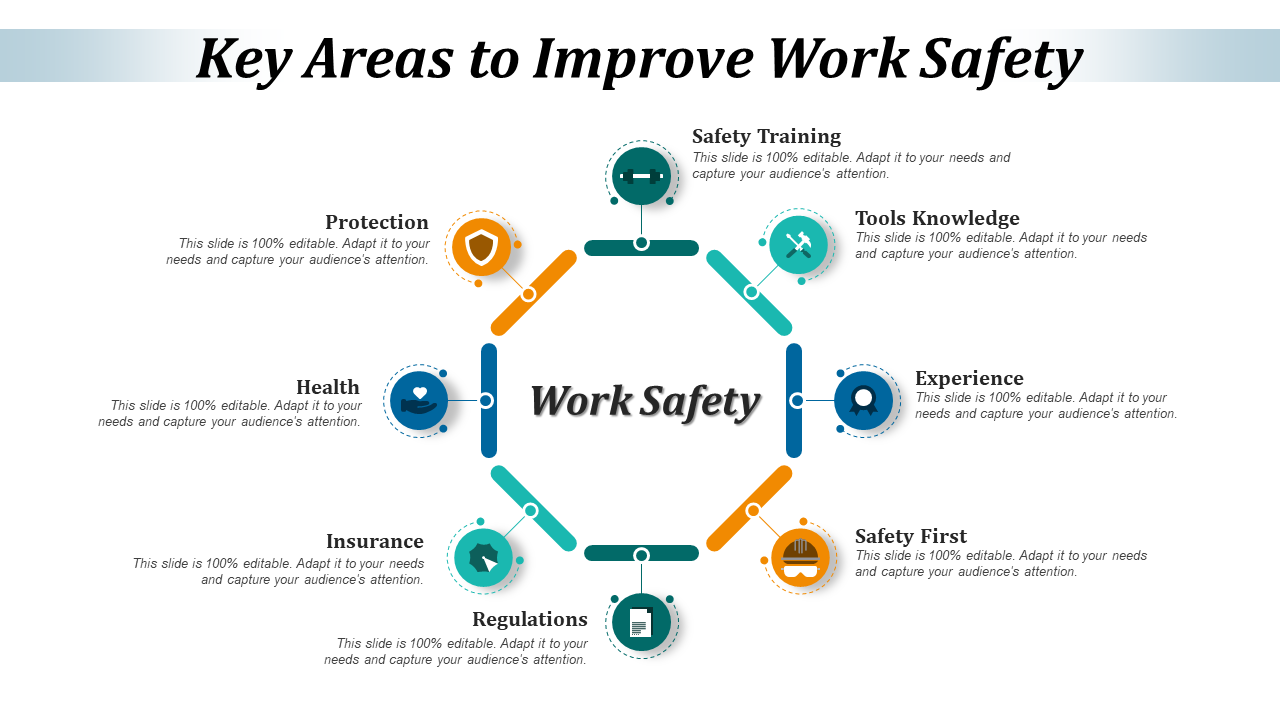
Download Key Areas To Improve Work Safety
Pick this template to provide a ground for exchanging ideas and data related to the broad field of health and safety in your organization. Help your management understand that an injury and accident-free environment increases the productivity of employees.
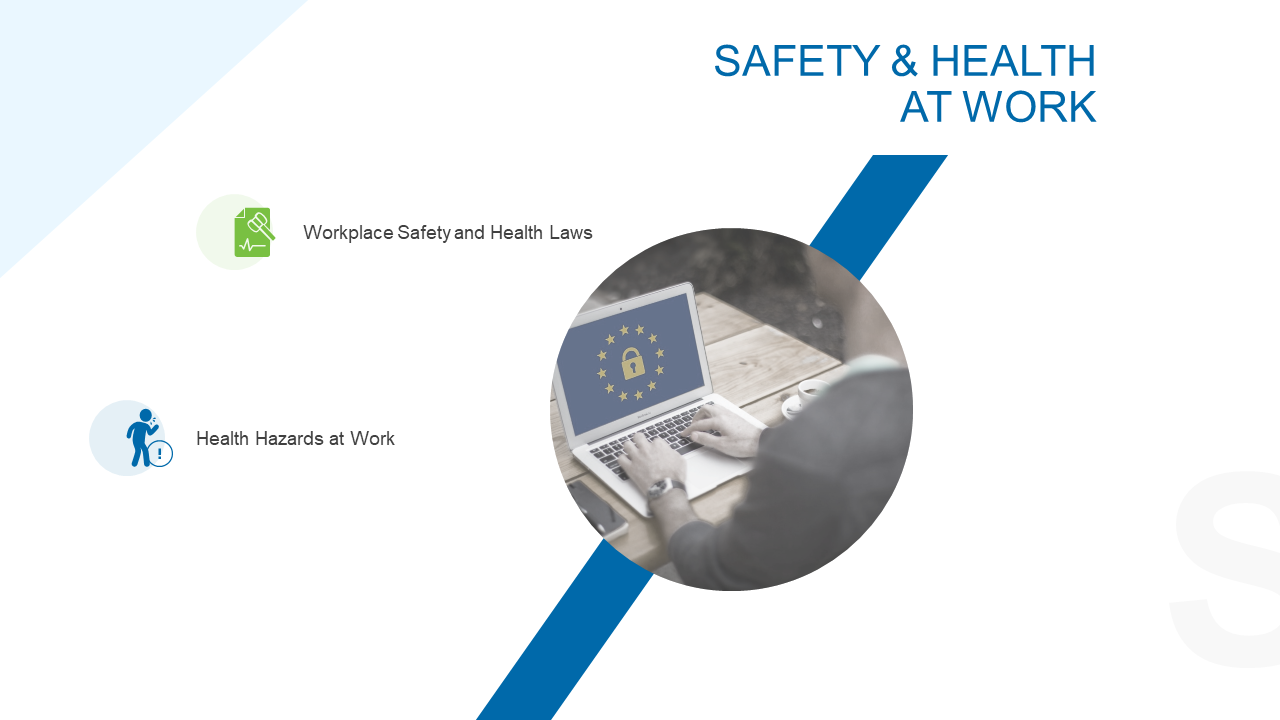
Download Safety And Health At Work PPT PowerPoint Presentation
According to an estimate of occupational safety and health administration, nearly a quarter of all work-related fatalities occur on construction sites. Therefore, you can utilize this template to draft safety guidelines for your construction business. Download this design and reduce the risk of deaths and injuries.
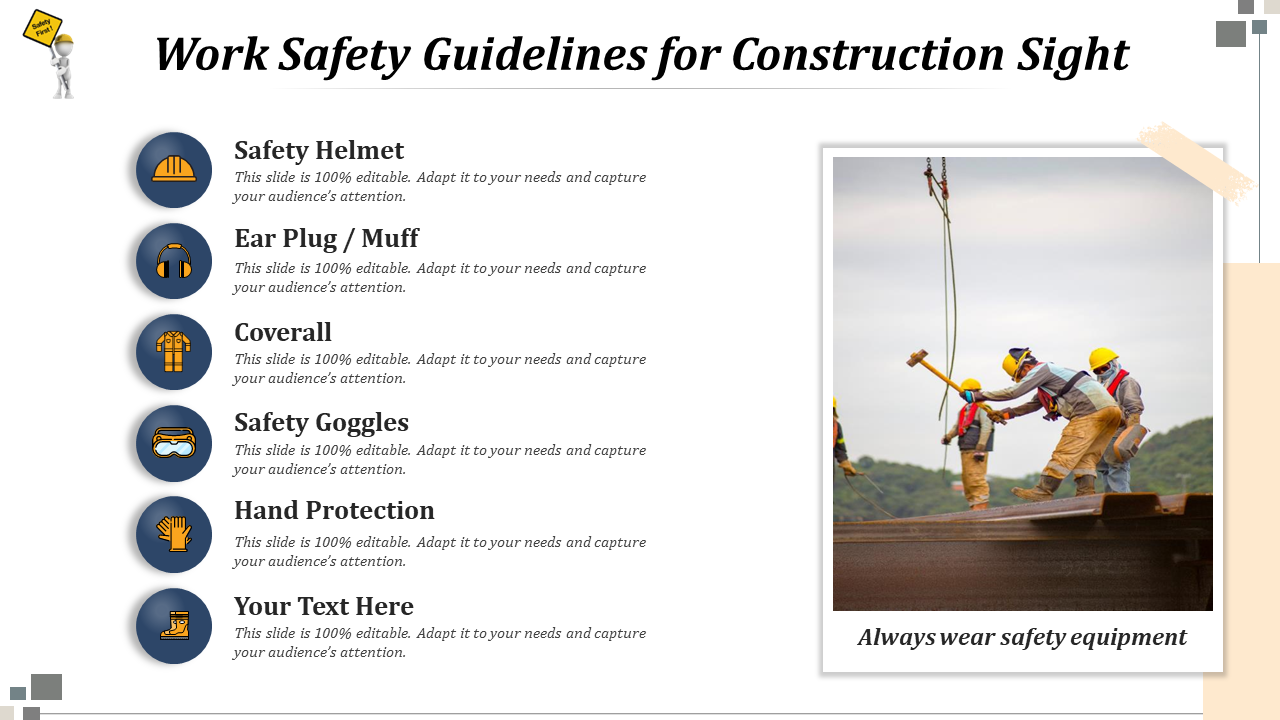
Download Work Safety Guidelines For Construction Sight
2. Provide clear instructions
The instructions should be in the form of labels and signs, not wordy and hard to understand. They should be handy and rely on pictures to highlight hazards and procedures. Therefore, it is advised to try and test them before they go “live”. Check out our best work safety templates to assist your endeavors.
Select this innovative work safety template to support awareness and actions for preventing the spread of COVID-19. To increase productivity and revenue, every business needs specific preventive measures. Therefore, download, edit, and present!
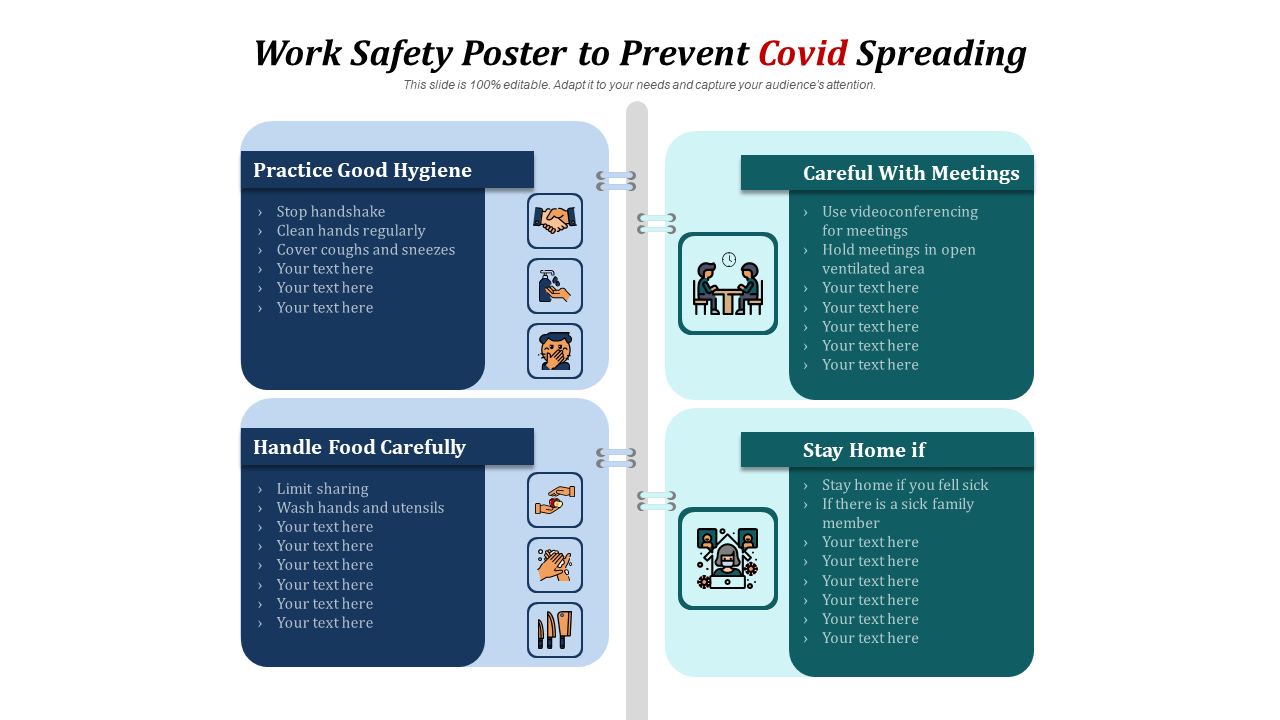
Download Work Safety Poster To Prevent Covid Spreading
Safety guidelines are critical for all organizations. Pick this template to share a prevention list with your employees. Help them understand that their negligence can put other co-workers at risk. Download and use it multiple times.
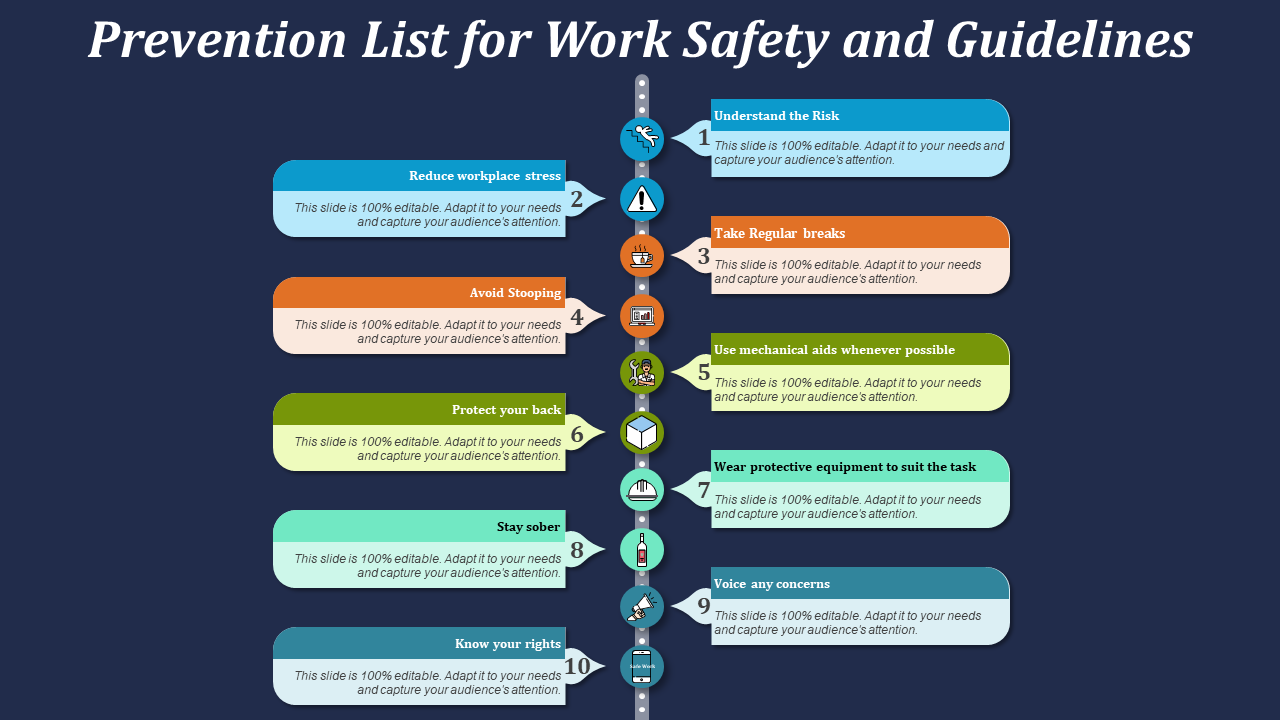
Download Prevention List For Work Safety And Guidelines
Hazard identification, assessment, and control are paramount for the smooth functioning of all organizations. With this crew safety template, you can develop a robust process to prevent people and materials from getting demolished. Download and edit it conveniently.
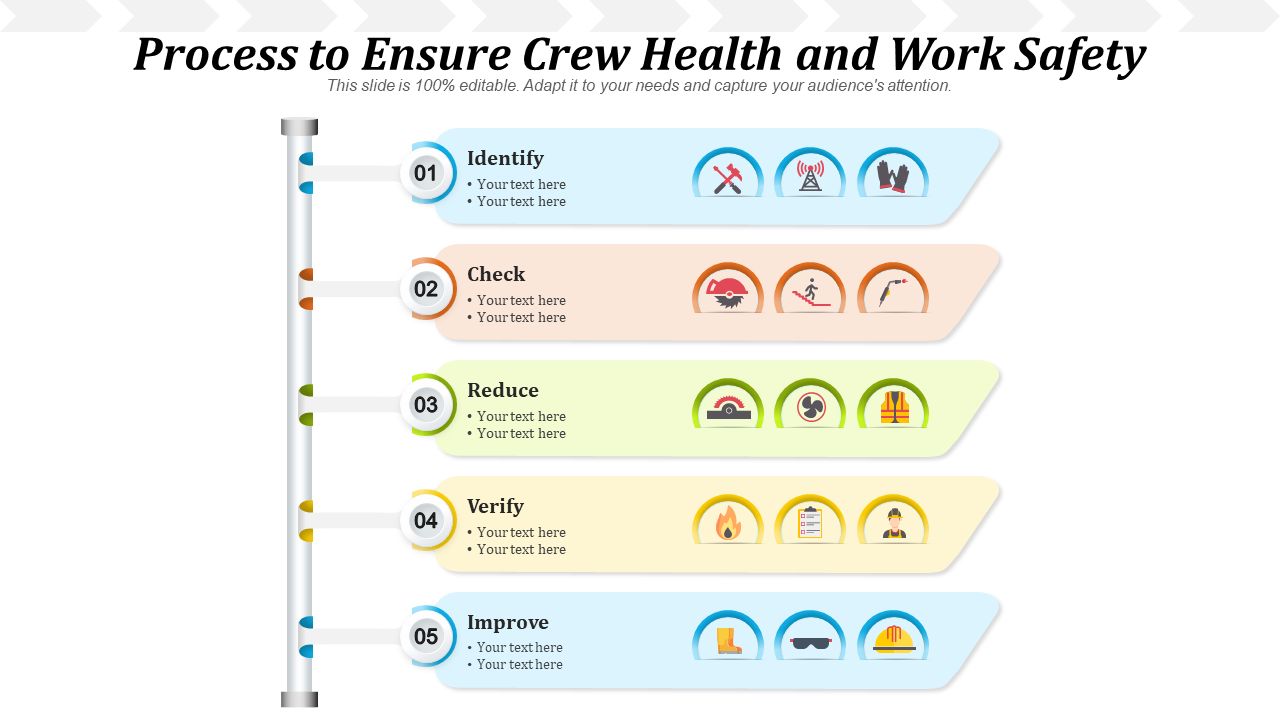
Download Process To Ensure Crew Health And Work Safety
3. Understand responsibility
This well-structured template can be used to quickly respond and mitigate the impact of a suspected security breach. So take advantage of this design to create an effective risk roadmap for your business.
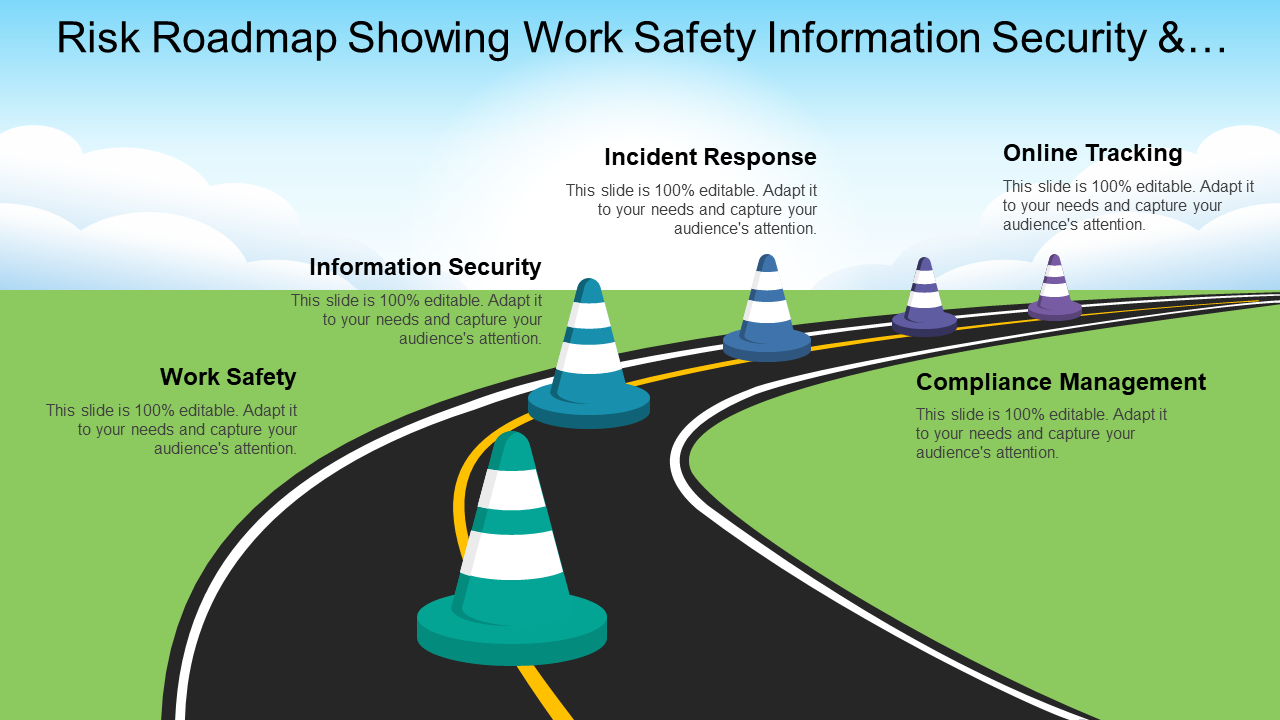
Download Risk Roadmap Showing Work Safety Information Security And Incident Response
Your safety is your personal responsibility! Pick this template and share such general precautions with your workforce. The template can be easily edited. So download and utilize it in any safety program presentation.
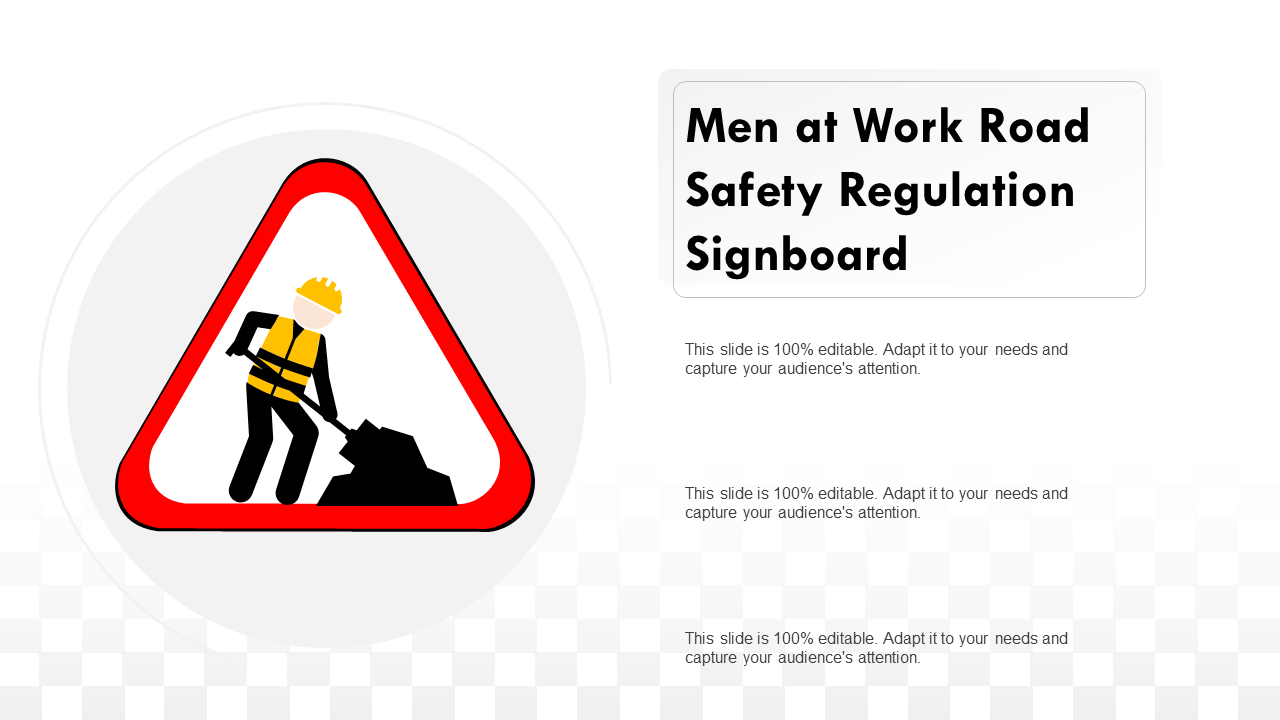
Download Men At Work Road Safety Regulation Templates
Accelerate the resumption of normal operations by employing this emergency response plan template. Include the procedures necessary during a crisis, set clear roles and responsibilities, and establish instructions for local emergency response. The template is easy to edit. So grab it right away!
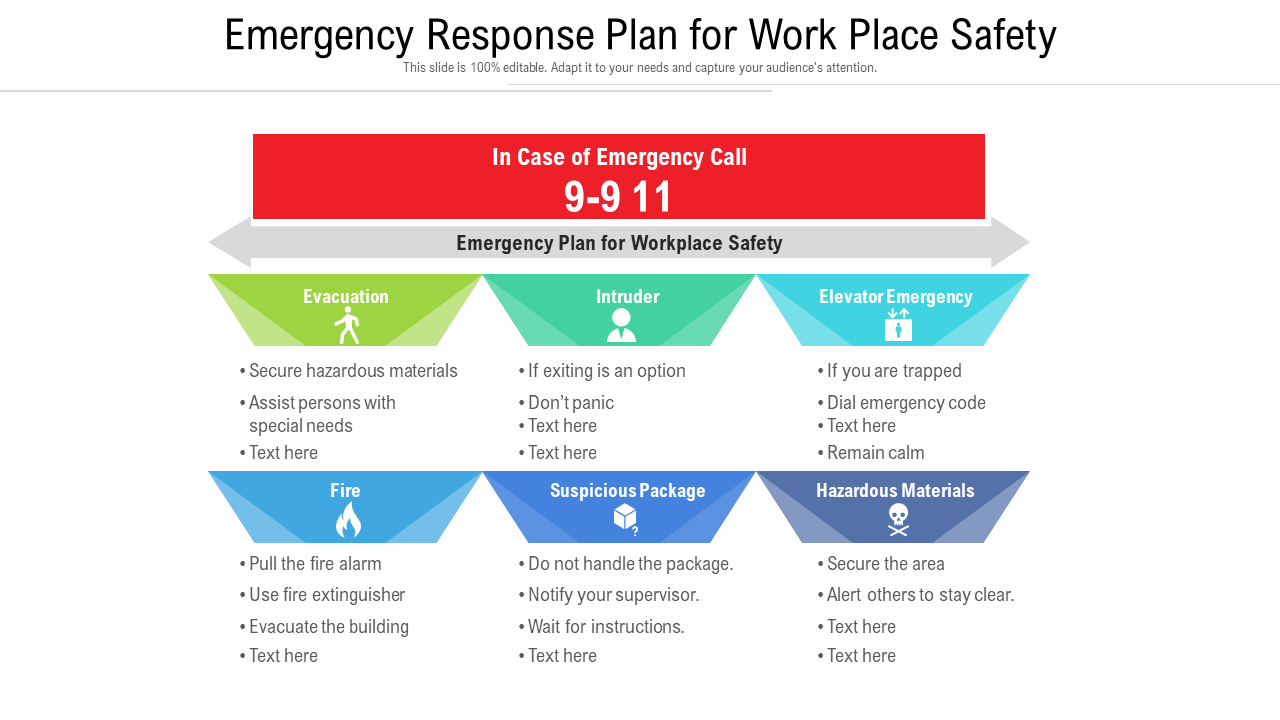
Download Emergency Response Plan For Work Place Safety
4. Partner with clinicians
Occupational clinics can provide valuable insights into workplace injury and prevention. Therefore, appoint them to visit your worksites and identify areas of high risk for employees. They can help you screen candidates for physically challenging roles and aid in the work processes. Sketch out a performance evaluation blueprint with these well-crafted templates.
Business operations come with multiple risks. Hence, being safe and healthy at the workplace is imperative. Download this visually appealing template to protect your business and employees from stressful situations.
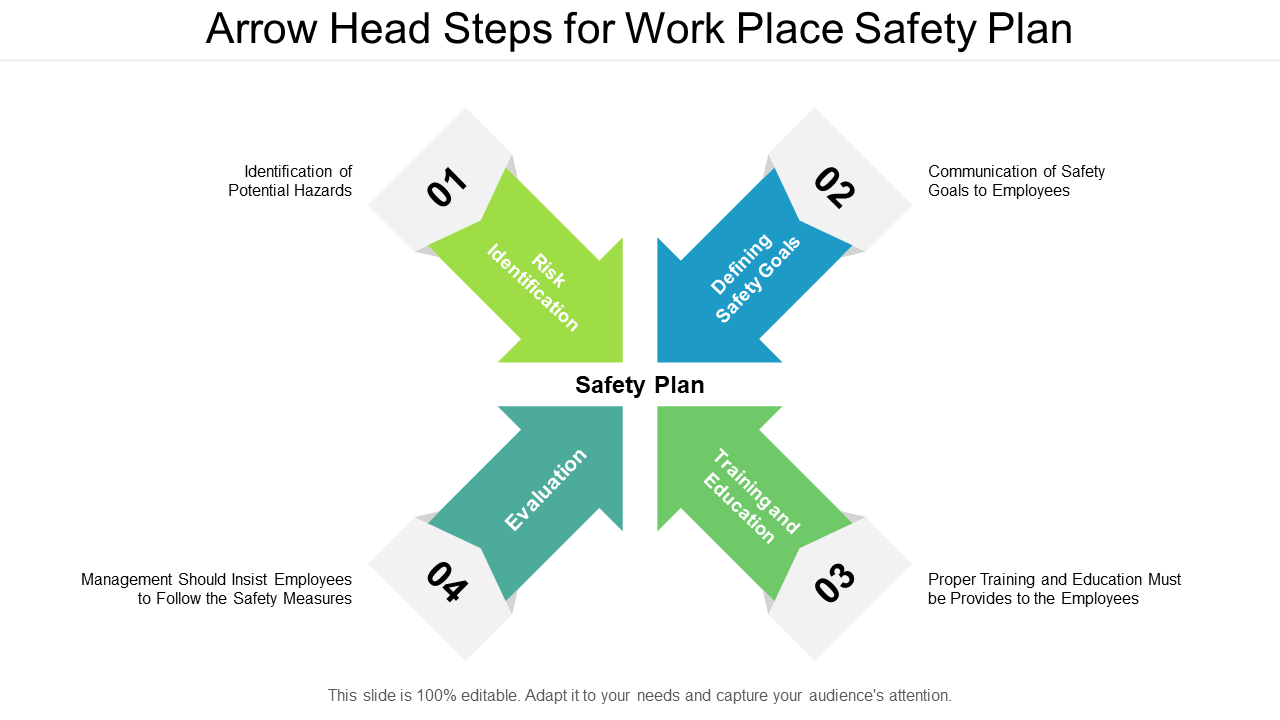
Download Arrow Head Steps For Work Place Safety Plan
Choose this template to ensure that your workers feel safe while operating in the facilities. Utilize it to create an organized safety management system that also complies with the local health and safety standards. The template already includes certain safety tips. Therefore, download and use it at your convenience.
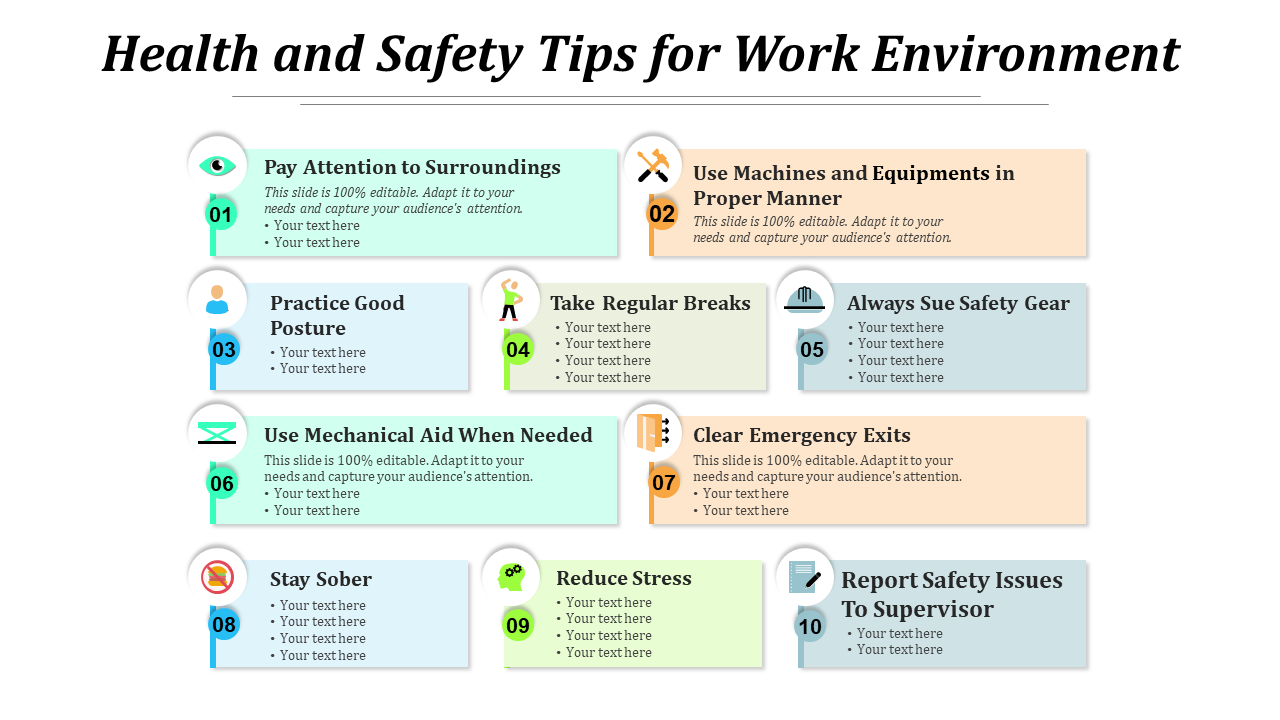
Download Health And Safety Tips For Work Environment
While resistance welding or brazing, the operators must use safety shields and goggles, depending on the job, to protect their eyes and face from any hazard. Pick this well-crafted template and encourage them to take extra protection from any hazardous condition.
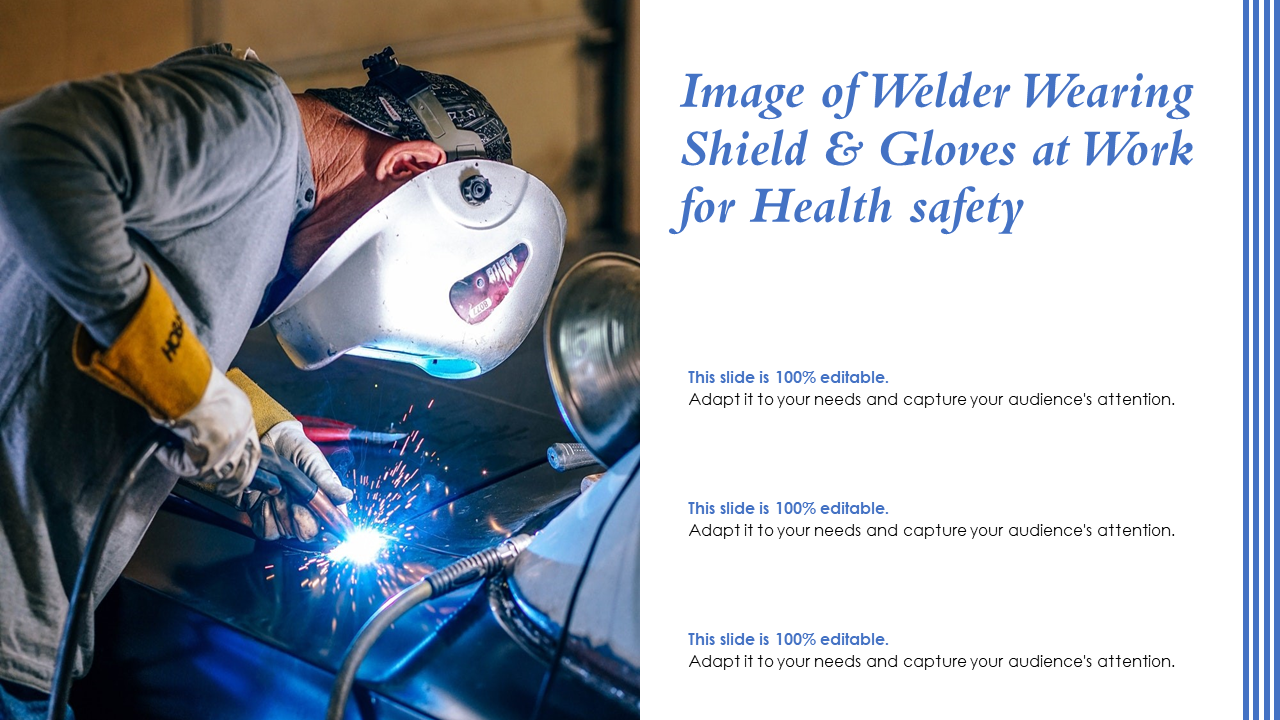
Download Templates Of Welder Wearing Shield And Gloves At Work For Health Safety
5. Encourage stretch breaks and regular meetings
Allow your employees to take stretch breaks because even a five-minute break can release muscle tension, loosen joints, and reduce the potential repetitive motion injuries. Besides, you should conduct regular meetings to review safety standards and rules. It doesn’t hurt to be prepared. Select from these invigorating templates and ensure if something wrong happens, everyone knows what to do.
Create a full-fledged manual for implementing safety precautions within your organization using this PowerPoint Template. Determine your primary objectives of safety toward your employees, followed by a framework on how you plan to implement it. Assemble all possibilities of health and safety tips and highlight work areas that in particular require attention. Specify health and safety tips for all departments under your organization and create a safe space for your employees by planning it with this editable PPT Template.
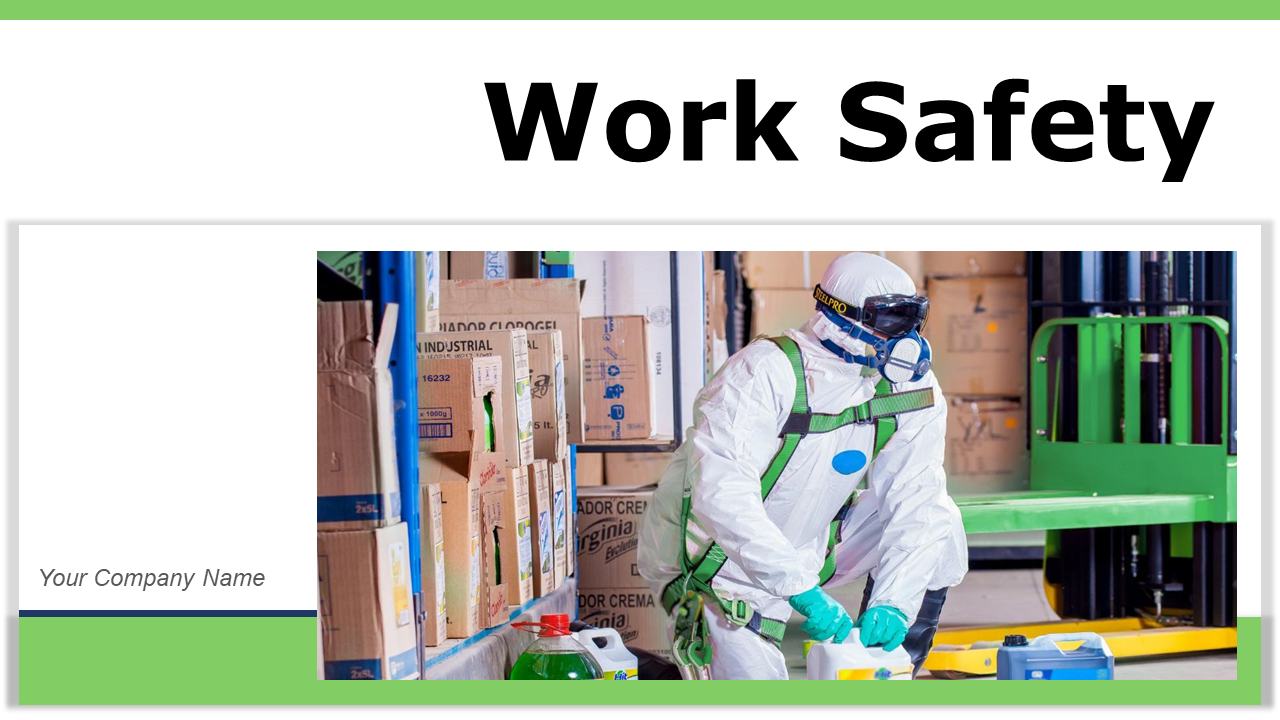
Download Work Safety Planning PowerPoint Template
This is yet another off-the-rack safety and health template slide. You can use it to elucidate the potential hazards of your industry. Share appropriate measures and steps to be taken in such situations. So download and prioritize safety.
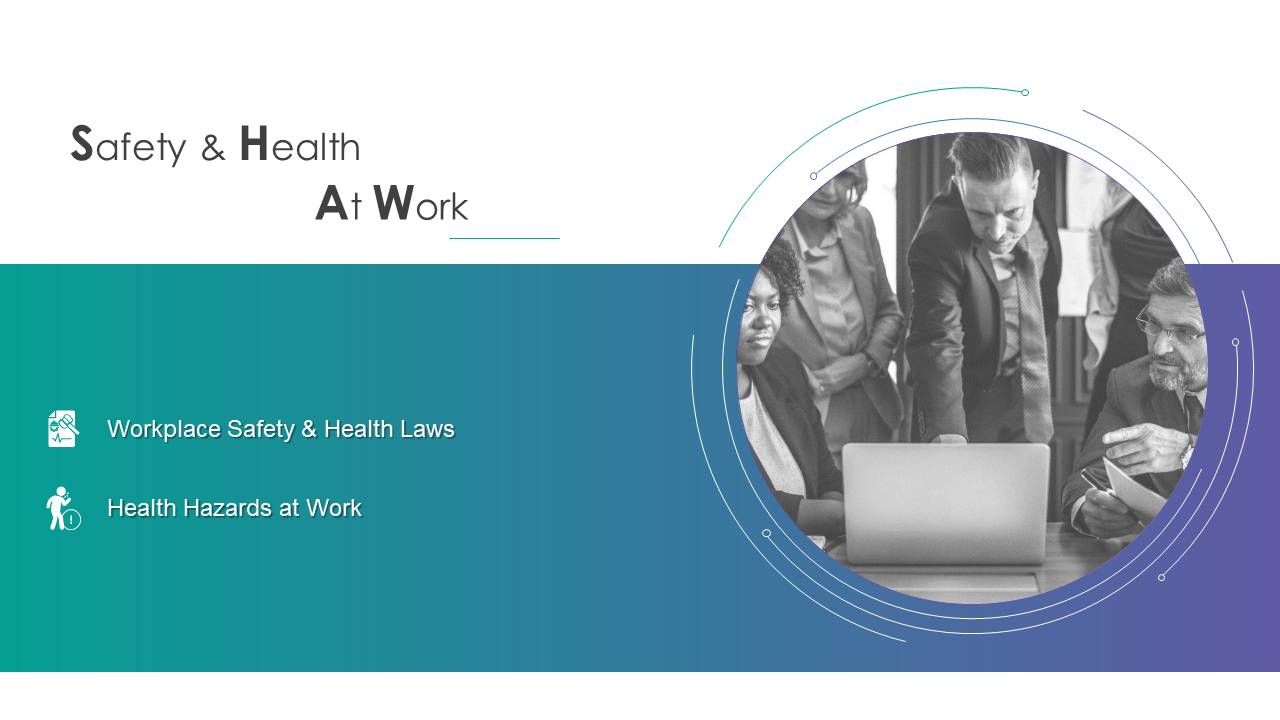
Create an invigorating workplace safety plan that provides a two-fold system of ensuring employee safety. Besides, you can also take advantage of the smart art given in the template and design a framework for policies and procedures to make safety a top priority. Therefore, grab it immediately!
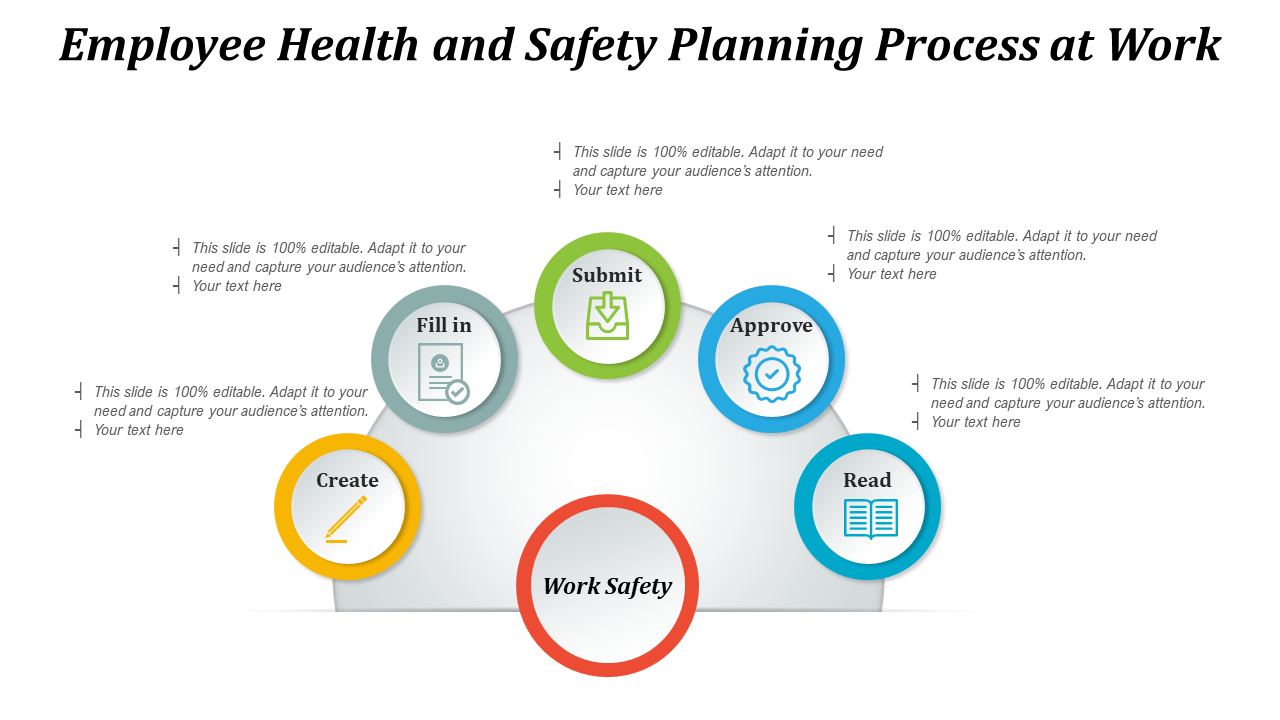
Download Employee Health And Safety Planning Process At Work
Safety training begins with leadership. Pick this template and help your management design committed safety policies. Explain your purpose and open up the communication lines between the administrators and workers. So download it and captivate your audience.
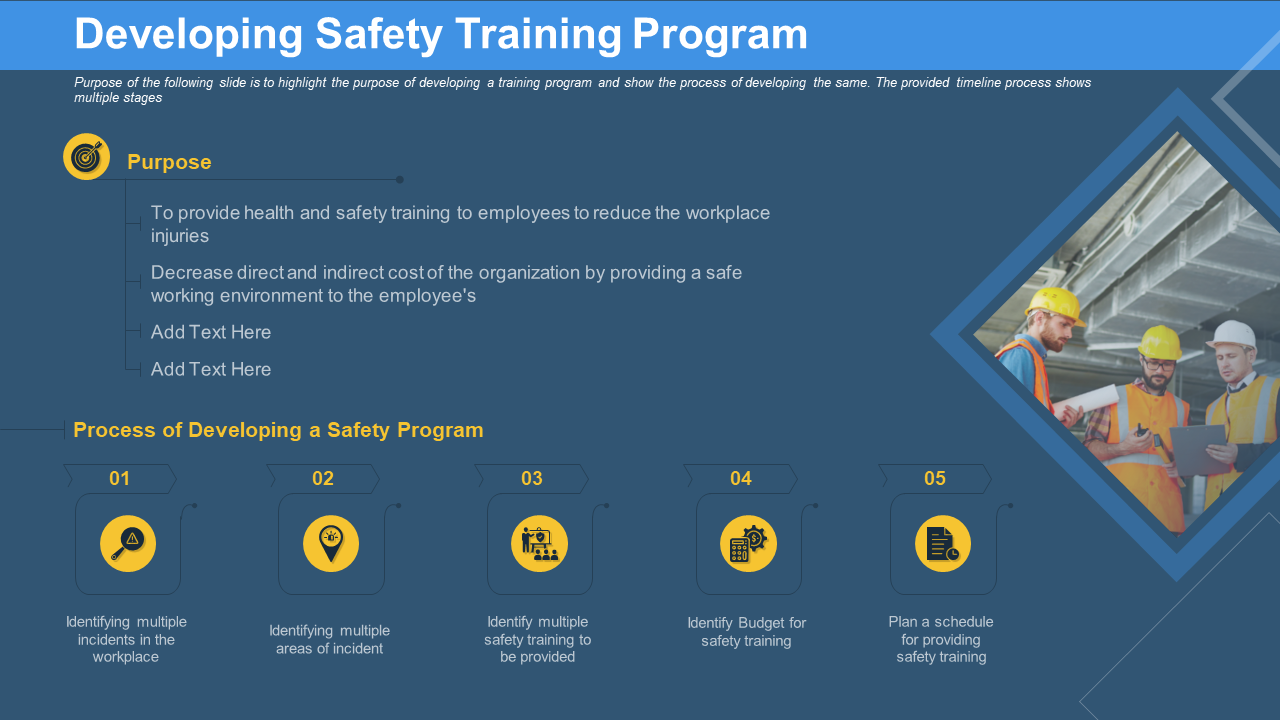
Download Developing Safety Training Program Safe Working
Prevention is better than cure! The meaning of safety and employers’ responsibility to prevent injury may vary with different working conditions. But regardless of the work your employees perform, their physical safety should never be out on a limb. Include all the tips mentioned in the blog and hit the health and safety goals of your business.
PS: You can also help your organization avoid potential losses from unpredictable hazards by exploring our top 20 crisis and disaster management templates here.
FAQs on Work Safety
What is workplace safety.
Workplace safety refers to the measures and procedures put in place to ensure the physical and psychological well-being of employees and other individuals in a workplace environment. The primary goal of workplace safety is to prevent accidents, injuries, and illnesses that may occur on the job, and to promote a culture of health and safety within the workplace.
Workplace safety covers a broad range of topics, including but not limited to:
- Hazard identification and risk assessment: identifying potential hazards in the workplace and assessing the risks associated with them.
- Safety policies and procedures: establishing and enforcing policies and procedures to ensure workplace safety, such as emergency evacuation plans, first aid protocols, and safe work practices.
- Training and education: providing employees with the necessary knowledge and skills to work safely, including training on equipment, machinery, and hazardous materials.
- Personal protective equipment (PPE): providing employees with appropriate PPE to protect them from workplace hazards.
- Workplace design: designing workspaces and equipment to minimize the risk of accidents and injuries. Health and wellness: promoting employee health and wellness to reduce the risk of illnesses and injuries.
- Health and wellness: promoting employee health and wellness to reduce the risk of illnesses and injuries.
Overall, workplace safety is an essential aspect of any workplace, and it is the responsibility of employers and employees to ensure that safety protocols are followed and maintained to prevent accidents and injuries.
What are the 7 safety tips?
There are many safety tips that can be applied in different situations and settings, but here are seven general safety tips that can be helpful in various environments:
- Pay attention to warning signs and signals: Be aware of warning signs and signals that indicate potential hazards and follow them.
- Keep emergency exits clear: Make sure emergency exits are clearly marked and free from obstruction.
- Use personal protective equipment (PPE): Wear appropriate PPE such as helmets, goggles, gloves, and safety shoes when working with hazardous materials or equipment.
- Practice good housekeeping: Keep the workplace clean and free of clutter to reduce the risk of slips, trips, and falls.
- Follow safe work practices: Follow established safety procedures and work practices, including using proper lifting techniques and avoiding shortcuts.
- Report hazards and incidents: Report any unsafe conditions, incidents, or injuries to your supervisor or safety team immediately.
- Take care of yourself: Take care of your physical and mental health to ensure that you are alert and able to work safely. Get enough rest, eat well, and take breaks when needed.
Remember that safety is everyone's responsibility, so be aware of your surroundings, follow safety rules and guidelines, and report any hazards or incidents to ensure a safe workplace for all.
What are the three types of safety?
There are three main types of safety:
- Physical Safety: Physical safety refers to protecting people from physical harm, injury, or illness. This includes protection from hazards such as falls, burns, cuts, and other injuries that may result from workplace accidents or exposure to hazardous substances.
- Psychological Safety: Psychological safety refers to creating a work environment that is free from harassment, discrimination, and other forms of negative behavior that can affect employees' mental and emotional well-being. This includes creating a culture of respect, openness, and inclusivity.
- Cybersecurity Safety: Cybersecurity safety refers to protecting digital assets, including information, data, and systems, from unauthorized access, theft, or damage. This includes protecting against cyber threats such as hacking, viruses, and phishing scams.
All three types of safety are essential in ensuring a safe and healthy workplace for employees and protecting a company's assets and reputation.
Related posts:
- [Updated 2023] Top 20 Crisis and Disaster Management PowerPoint Templates for Organizations to Sail Through!
11 Disaster Management PowerPoint Slides To Help You Prepare For Any Fateful Event
- Top 20 Templates to Present Your Company’s Disaster Management Strategy
- Must Have Emergency Operations Plan Templates with Samples and Examples
Liked this blog? Please recommend us

Top 10 Corporate Training Templates to Upraise Productivity and Employee Satisfaction
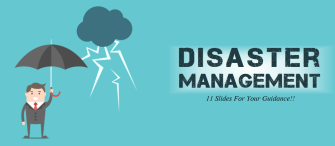
2 thoughts on “[Updated 2023] Top 15 PowerPoint Templates to Improve Work Safety”
This form is protected by reCAPTCHA - the Google Privacy Policy and Terms of Service apply.

Digital revolution powerpoint presentation slides

Sales funnel results presentation layouts
3d men joinning circular jigsaw puzzles ppt graphics icons

Business Strategic Planning Template For Organizations Powerpoint Presentation Slides

Future plan powerpoint template slide

Project Management Team Powerpoint Presentation Slides

Brand marketing powerpoint presentation slides

Launching a new service powerpoint presentation with slides go to market

Agenda powerpoint slide show

Four key metrics donut chart with percentage

Engineering and technology ppt inspiration example introduction continuous process improvement

Meet our team representing in circular format

Home PowerPoint Templates Safety
Safety Presentations for PowerPoint and Google Slides
Our innovative Safety Slide is key for creating engaging and impactful safety presentations effortlessly. With this powerful template, you can communicate crucial precautions and safety measures to your audience. No more hassle designing or preparing complex slides – we have streamlined the process for you, ensuring clear and concise visuals that leave a lasting impression.
You can use our 100% editable Safety Slide to give your presentations a personal touch. They are easily downloadable, and you can quickly edit the placeholder with your plan to suit your presentation content. It saves time, energy, and resources, making your presentation unique. Download our Safety Slide now and captivate your viewers with a presentation that speaks volumes.
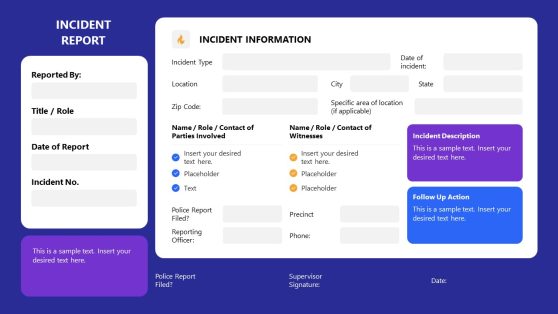
Incident Report PowerPoint Template
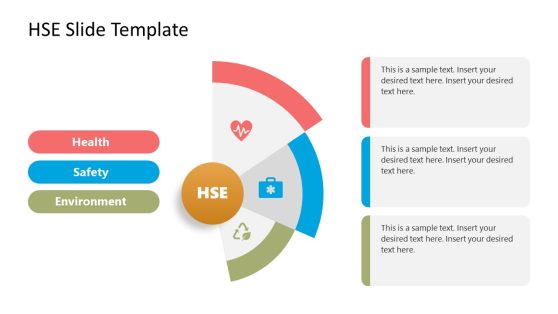
HSE PowerPoint Template Diagram
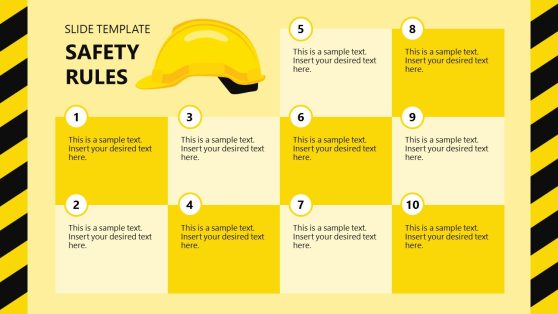
Safety Rules PowerPoint Template

Exit Sign PowerPoint Template
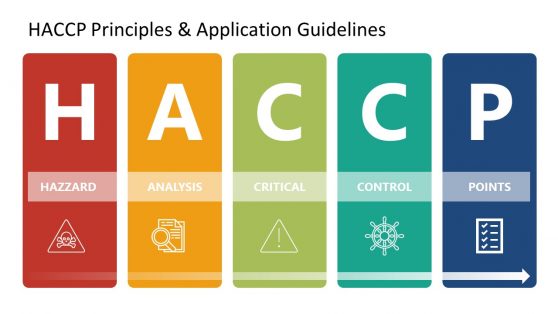
HACCP Principles and Application PowerPoint Template
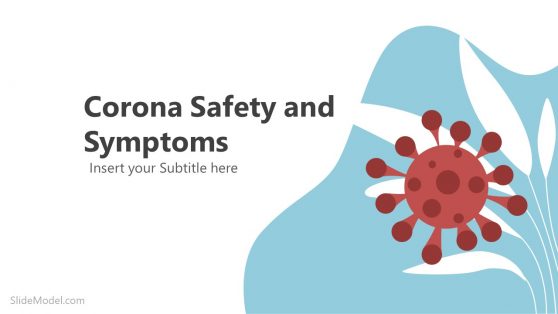
Coronavirus Safety and Symptoms PowerPoint Template
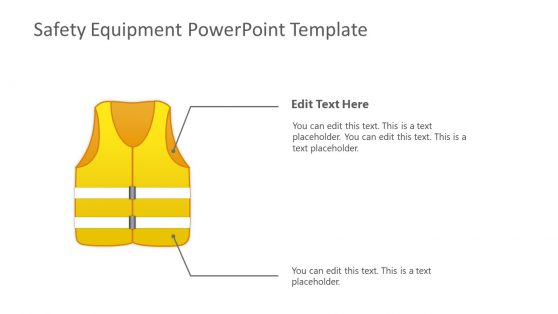
Safety Equipment PowerPoint Template
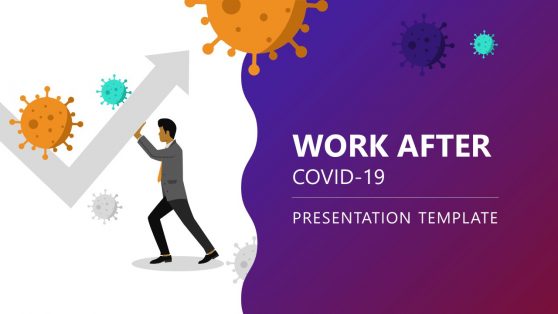
Work After COVID-19 PowerPoint Template

Security Agency PowerPoint Template
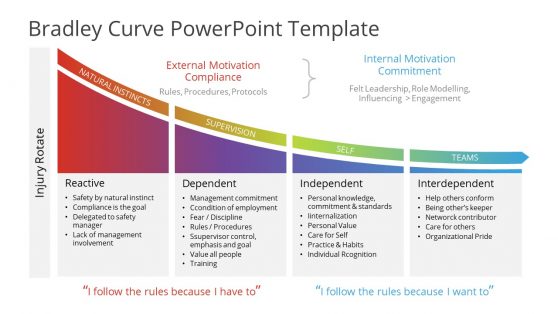

Bradley Curve PowerPoint Template

Animated Safe Shapes Template for PowerPoint
Safety means protection from harm, danger, or injury. It’s about minimizing or eliminating potential risks to keep people, property, and the environment safe. Our templates help educate your audience about hazards and provide guidelines.
Our Safety Slide PowerPoint Template is a creative tool for presenting safety rules. These rules guide risk control and protection for processes, personnel, and equipment. Defining specific rules is crucial before implementing standard protocols. Our templates benefit professionals like doctors, engineers, teachers, and more.
These templates are perfect for training, workshops, and business presentations; this versatile slide enhances safety awareness. Engage your audience with graphics and easy-to-understand content, promoting a culture of safety and security.
These templates come in various colors, fonts, icons, images, and diagrams, suitable for formal and informal settings across industries. They work on Mac and Windows, Keynote, and Google Slides. Download, customize, and captivate your audience, concluding your presentation with applause.
What Is A Safety Slide Template?
A Safety Slide Template is a pre-designed PowerPoint slide created to convey safety-related information or guidelines to your audience. It serves as a visual aid in safety presentations, training sessions, or any context where promoting safety awareness and practices is essential.
What Should A Safety Presentation Include?
A Safety Presentation should include the following key elements:
- Introduction
- Safety Policies
- Hazard Identification
- Safety Tips
- Emergency Procedures
- Safety Equipment
- Case Studies
- Q&A Session
Why is a safety presentation important?
A safety presentation is crucial to raise awareness about potential hazards and best practices in promoting a safe working environment. It helps educate employees or individuals on safety protocols, reducing the risk of accidents, injuries, and property damage. Prioritizing safety fosters a culture of responsibility and care within an organization or community.
How Do You Create A Safety Slide In PowerPoint?
To create a safety slide in PowerPoint, you should follow the below-listed steps:
- Open the PowerPoint software and select a slide layout that is suitable for you.
- Add a clear title that reflects the slide’s purpose, such as “Safety Guidelines” or “Safety Tips.”
- Organize the safety information using bullet points.
- Enhance the slides using relevant images or icons to represent safety concepts while maintaining a consistent color scheme.
- Use icons and limit the text to avoid overcrowding.
- Optionally, add subtle transitions or animations for a smoother presentation.
The goal of using a Safety Slide is to communicate essential safety guidelines and encourage your audience to prioritize safety in their actions and decisions.
Can I Customize the Safety Slide Template to Suit my Organization’s Needs?
Yes, the safety slide template in PowerPoint is 100% editable. You can modify the content, layout, colors, and visuals to align with your organization’s safety policies and branding. Customizing the template allows you to tailor the safety presentation to address unique safety concerns or requirements.
Download Unlimited Content
Our annual unlimited plan let you download unlimited content from slidemodel. save hours of manual work and use awesome slide designs in your next presentation..
- Agriculture
- Construction
- Manufacturing
- View all industries
- Case Studies
Top 10 Construction Safety Topics in 2020 (with Templates)

The year 2020 has been intense, to say the least. Construction companies, facing the first pandemic in decades, are required to protect workers from COVID-19 transmission as well as from respiratory hazards during a face mask shortage .
The top meeting templates used by construction companies in 2020 so far reflect the ongoing COVID-19 situation: handwashing is the top meeting. But they also reflect a persistence in choosing safe operations in the midst of change and uncertainty.
How We Arrived at This List
The top construction meetings were pulled from anonymous, aggregated data in our free safety management system . With Safesite , you can:
- Access meeting templates
- Start a meeting
- Check-off key points as they are addressed
- Easily take attendance and document the meeting
As you might expect, this list is slightly skewed toward national contractors. It also doesn’t include company-owned templates that our users upload to their projects.
We’ll update this list throughout the year to reflect the most up-to-date information.
This Year’s Most Popular Construction Safety Topics
Without further ado, here are the top 10 safety meeting topics used by construction companies on Safesite. You can log and take attendance for these meetings with Safesite. Get started free !

Effective Hand Washing Toolbox Talk
According to the CDC, handwashing is one of the best ways to prevent the spread of illness. In a time of heightened risk posed by COVID-19, construction companies face the challenge of ensuring good hygiene practices with limited resources at field job sites.
This safety moment can be held in the field to remind workers that the small act of handwashing can save lives and keep the crew working. Optional: Use this mobile-friendly PPT to assist in your presentation.
Run the Hand Washing Toolbox Talk >
COVID-19 Daily Guidelines Safety Meeting
Review your COVID-19 policies and procedures with this safety meeting. Edit this template to fit your needs based on local guidelines and COVID-19 transmission. Tip: get the full COVID-19 PPT .
Download the COVID-19 Daily Guidelines Safety Meeting >

Slips, Trips, and Falls Safety Meeting
This meeting covers walking/working surfaces and how to avoid slips, trips, and falls, which are the most frequently occurring working injuries. Use the Slips, Trips, and Falls PPT in the classroom setting.
Your job sites change week-to-week, so this evergreen template can be tweaked as the build progresses and new contractors arrive.
Download the Slips, Trips and Falls Safety Meeting >

Eye Protection Toolbox Talk Template
Review the tasks involved on each stage of your project and the required eye protection for each. This toolbox talk template may be edited according to your procedures for providing, caring for, and replacing eye protection on the job. Use the Eye Protection PPT or use your own PPE during your demonstration (recommended).
Run the Eye Protection Toolbox Talk >

Back and Lifting Safety Meeting
This meeting covers lifting best practices and ergonomics. Your crews will learn about the back itself and how to avoid painful injuries. Use the Lifting Safety PPT or run your own demonstration (recommended).
Download the Back and Lifting Safety Meeting >

Driving Skills Meeting Template
Remind your crew why safe driving skills are essential whether they’re on or off the clock. Accidents are a leading cause of injury or death, and in today’s world of distractions, it’s more important than ever to stay on your guard. Use the Safe Driver PPT (optional) during your meeting.
Download the Driving Skills Safety Meeting >

General Ladder Safety Toolbox Talk
More than 24,000 injuries and 36 deaths occur every year in the US from ladder accidents. This meeting can be used by foreman and safety leaders to educate employees on the correct inspection, selection, and use of ladders within the construction environment. Use the Ladder Safety PPT or run your own demonstrations (recommended).
Download the General Ladder Safety Toolbox Talk >

Signs, Signals, and Barricades Safety Training
Review sign, signal, and barricade basics to remind your workers of the importance of displaying and obeying proper signage during road work or on job sites near roads and parking lots. Use the Hazard Signals PPT or run your own setup demonstration (recommended).
Download the Signs, Signals, and Barricades Toolbox Talk >

Be Prepared: In Case of an Emergency Safety Meeting
Review your emergency procedures on every new job site, including fire prevention equipment, exits, and procedures. Use this meeting to encourage every worker to take workplace hazards seriously and know what to do if an incident occurs. Use the Emergency Preparedness PPT or run your own demonstrations (recommended).
Run the Emergency Preparedness Safety Meeting >

Accident Investigation Safety Meeting Template
Train your staff on the importance of conducting immediate, thorough investigations — ahead of time. This meeting covers the importance of participating in witness statements and reminds crews that it’s not about placing blame, it’s about preventing future occurrences. Use the Accident Investigation PPT in the classroom setting.
Download the Accident Investigation Safety Meeting >
Running and Documenting Your Safety Topic Discussions
You can use the meetings feature in your Safesite app to hold safety meetings with or without a PowerPoint presentation. Just open the app on your phone or tablet, select Conduct Meeting , search the Template Library for a specific meeting or customize your own.

Each of the presentations listed in this article follows a corresponding meeting template in Safesite. You can use the PPT or the meeting for talking points during your presentation.
After your meeting, you can log attendance with Safesite by tagging users or adding a photo of the sign-in sheet. Use the talking points on Safesite or your slides to guide your presentation. Keep your presentations brief and positive. Select Finish to conclude and log your meeting. Visit our support center to learn more about conducting a meeting with Safesite .
Improve Safety Participation in 2020 and Beyond
The top 10 construction meetings for 2020 reflect measures to keep workers safe during COVID-19 . They also highlight the need to prepare in advance for high-impact situations like emergencies and incidents
Instantly document your safety meetings with Safesite . Record the date training occurred, attendee names, and if required, schedule an alert for renewal.
Safety meetings can accomplish more than awareness of a certain task or topic. They can boost the effectiveness of your safety training and overall safety participation. Choose from one of many templates in the library or upload your own today.
- First name *
- Last name *
By Team Safesite
We're a group of safety and tech professionals united in our desire to make every workplace safer. We keep a pulse on the latest regulations, standards, and industry trends in safety and write about them here on our blog.
This article covers:
Related blog posts, ladder inspections and checklists for ladder safety, a short guide to osha recordkeeping requirements, construction careers: jackie guttman, project manager + professional engineer (pe).

Login to my account
Enter your e-mail and password:
New customer? Create your account
Lost password? Recover password
Recover password
Enter your email:
Remembered your password? Back to login
Create my account
Please fill in the information below:
Already have an account? Login here
Your cart is empty
Free Safety Training PowerPoints
Here is a directory of free safety training PowerPoints. These are not owned or endorsed by Affordable Safety Training LLC. Use them at your discretion.
Free Safety Training Power Points
Aerial Lift PowerPoints
Asbestos PowerPoints
Bloodborne Pathogens PowerPoints
Confined Spaces PowerPoints
Construction PowerPoints
Crane and Rigging Safety PowerPoints
Driving Safety PowerPoints
Electrical PowerPoints
Excavation and Trenching PowerPoints
Fall Protection PowerPoints
Forklift Operator PowerPoints
Hazard Communication and GHS PowerPoints
Heat Stress PowerPoints
Hydrogen Sulfide PowerPoints
Ladder Safety PowerPoints
Lockout Tagout PowerPoints
Machine Guarding PowerPoints
Mine Safety PowerPoints
Recordkeeping PowerPoints
Respirator Safety PowerPoints
Scaffolding PowerPoints
Scissor Lift PowerPoints
Silica PowerPoints
Tractor Safety PowerPoints
Subscribe to our newsletter.
Sign up for deals, announcements and free resources!
100% free, Unsubscribe any time!
Quick Shipping
Get Your Order Fast
Satisfaction Guarantee
30 Day Money Back Guarantee
Top-notch support
Chat, Call, Email or Text
Secure payments
Payment Information Not Stored
- Opens in a new window.
Join our team
View our current job opportunities.
System Integration Partner
Vista Projects specializes in the implementation, configuration, administration, and support of AVEVA’s Asset Information Management suite.
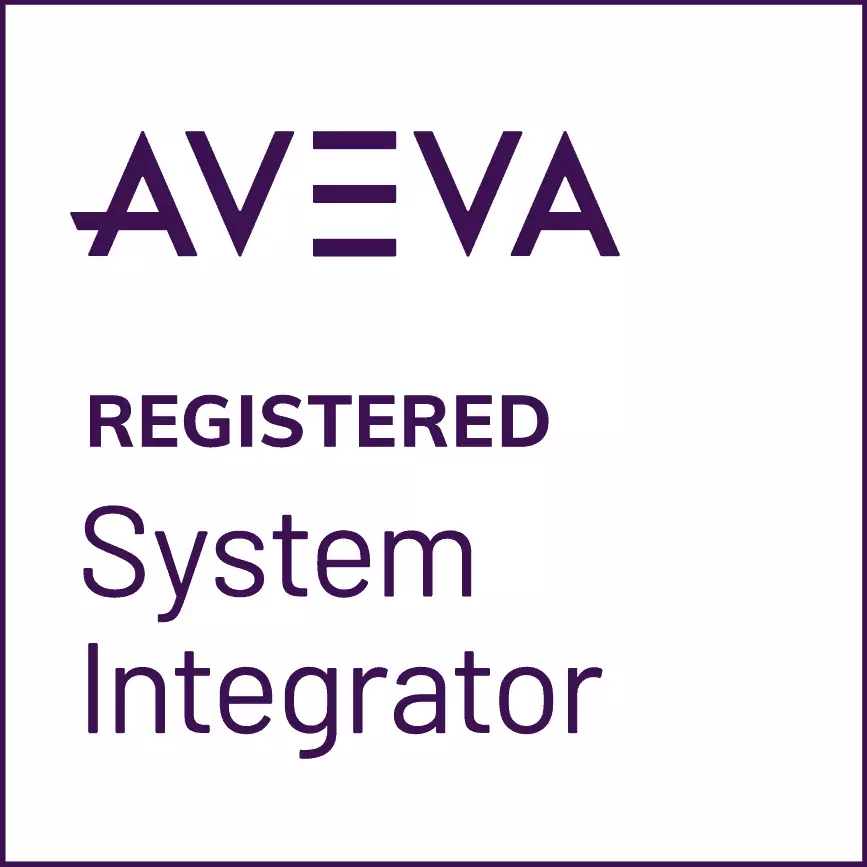
Long-Term Success
We approach each project with the same outlook. Our goal is always to help clients meet their short-term project objectives while also preparing the asset for long-term success.
Intelligent Data Starts with Engineering
Download our brochure about Data-Centric Execution Architecture to learn more.
Media Contact
Are you interested in interviewing someone from Vista, using our logo, or talking to us about speaking opportunities?
Latest Post

10 Workplace Safety Topics for Meetings to Bookmark
- Adam Singfield
- Last Updated July 9, 2019
- Category Industrial Engineering

Workplace safety moments, or toolbox talks, can cover a variety of topics. These are regular opportunities for coworkers to discuss safety issues at work, whether it’s dealing with workplace hazards or engaging in healthy work practices.

- Informs people about workplace risks and safety training
- Gives the chance to evaluate prior safety-related incidents
- Keeps people alert and aware of potential hazards
Safety meeting topics can vary, from tips to avoid carpal tunnel to explaining company protocols around COVID-19. The important thing is that everyone in your organization is regularly thinking about safety. That is our goal as an engineering services firm and system integrator .
So, what are some good safety topics to incorporate in your meetings or talks around the toolbox? Here are 10 workplace health and safety topics to ensure your workforce is always focused on avoiding injuries or illnesses.
10 Everyday Workplace Safety Topics for Meetings
1. general safety mistakes.
Proper use of personal protective equipment (PPE) is one of the simplest ways to ensure the safety of your employees. It’s crucial to advise and train employees in using protective equipment, such as prescription lenses, protective hearing devices, foot and arm protection, and other protective equipment.
For example, it’s wise to ask employees to wear hard hats if there’s a danger of falling objects in the workplace. Inform them about using face shields and gloves to prevent scratches, cuts, or possible infections.
2. Ergonomic and Workplace Stress

Work-related stress, fatigue, depression, and anxiety also account for a large percentage of workplace health issues. Uneven workload patterns, toxic cultures, infrequent breaks, and many other factors can contribute to stress and discomfort. To reduce work-related stress, try to:
- Ask for help
- Communicate problems clearly
- Meditate and try other relaxation techniques
Creating a work culture that encourages conversations about stress and work-life balance promotes a healthy work environment .
3. Drugs on The Job

4. Violence at The Workplace
Workplace or occupational violence can result from employees, customers, visitors, or clients engaging in any kind of disruptive behaviour.

5. Fire and Electrical Safety
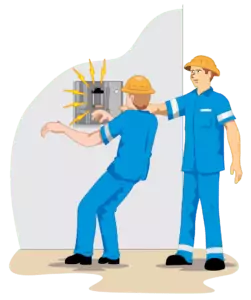
- The whereabouts of fire extinguishers
- How to use fire extinguishers
- Quick evacuation routes if/when necessary
Accidents caused by electricity can often be fatal. Knowing how to be careful with electrical equipment and devices at work is of the utmost importance. It’s vital for any safety meeting to discuss the consequences of not wearing proper protective gear while working with electrical wires or being careless around them.
6. Workplace Accidents: Reporting, Prevention, And Costs

Talking about accidents is essential to every pre-work safety meeting. Employees should know how and why accidents happen at the workplace and what they can do to avoid them.
In case an accident does occur, workers should have adequate reporting procedures in place. A safety meeting is the best place to familiarize workers with workplace accident reporting procedures.
7. Heat Exhaustion and Safety
Heat exhaustion results from the body’s inability to cool down and regulate its internal temperature. It is usually caused by continuous exposure to excessive heat that dehydrates the body.
Symptoms of heat exhaustion include:
- Dizziness and fainting spells
- Nausea and vomiting
- Muscle cramps
Symptoms of heatstroke:
- Behavioural changes (irritability, confusion, disorientation)
- Muscle and abdominal cramps
If left unattended, heat exhaustion can worsen and turn into heatstroke. Heat strokes have the potential to be life-threatening . It’s crucial to inform your employees about the signs, symptoms, and prevention of heatstroke.
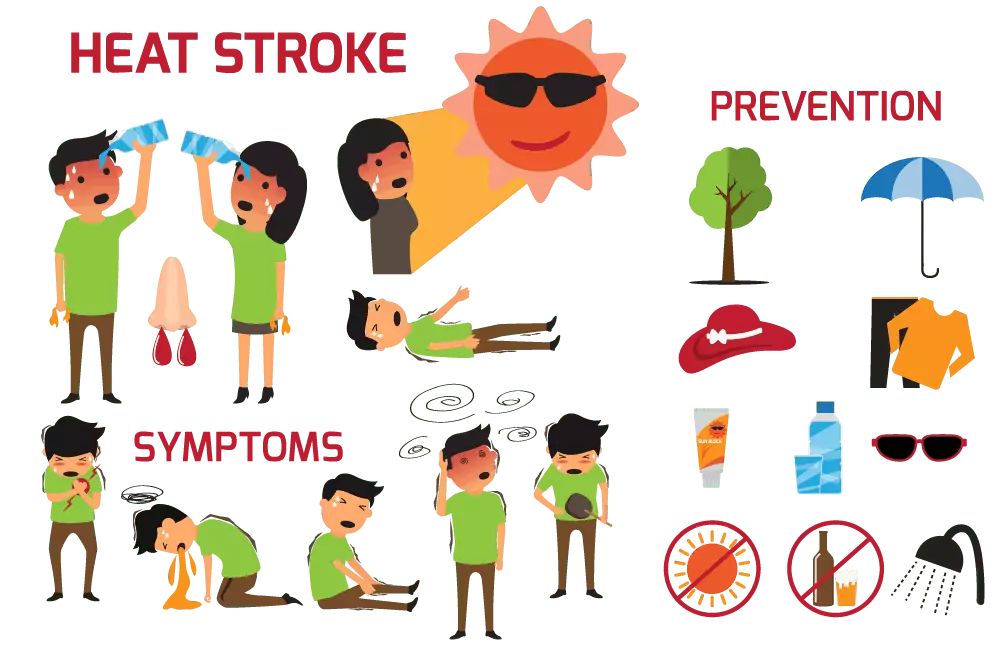
8. Workplace Injuries

- Trips and falls
- Being hit by unguarded machinery or falling objects
- Violent acts in the workplace
- Stress, fatigue, and overexertion
- Vehicle-related mishaps
- Repetitive motion injuries
- Exposure to hazardous materials
Talking about how such injuries happen and what workers can do to avoid them should be a key element of a safety meeting. Organizations should inform workers on procedures and training that help protect them from accidents in the workplace.
9. Silica Dust and Protection
Prolonged exposure to particles of crystalline silica can lead to serious and fatal illnesses. Examples include chronic silicosis, interstitial lung disease, and even cancer. People who work in mining , steel, glass, and construction industries are more prone to silica-induced diseases.
It’s essential for these industries to hold safety meetings to discuss how workers can protect themselves from silica dust.
Some common materials that contain silica are:
- Cement and mortar
- Abrasives used for blasting
- Tiles and masonry
- Sand and granite
Some protective measures include:
- Dust control and suppression
- Exposure monitoring training
- Wearing PPE
- Banning smoking in areas where silica dust is present
10. Communication Issues and Safety
Lack of communication between employees can be a major reason for workplace accidents. Pre-work safety meetings, or toolbox talks, are a good platform to clarify the roles and responsibilities defined within a company’s safety program.
Occupational Health and Safety
Occupational safety and health are shared responsibilities. Both employers and employees have roles to play in maintaining a safe working environment. Meeting topics are a great way to communicate these responsibilities.
- Business owners are responsible for providing safe working conditions. This is typically achieved through the implementation of safety procedures. Employers must also have workers compensation insurance.
- Employees should know how work will be done for the day, who’s responsible for what, and the general safety protocols. In case verbal communication fails, people should have other effective means to communicate.
How to Effectively Communicate Workplace Safety Practices
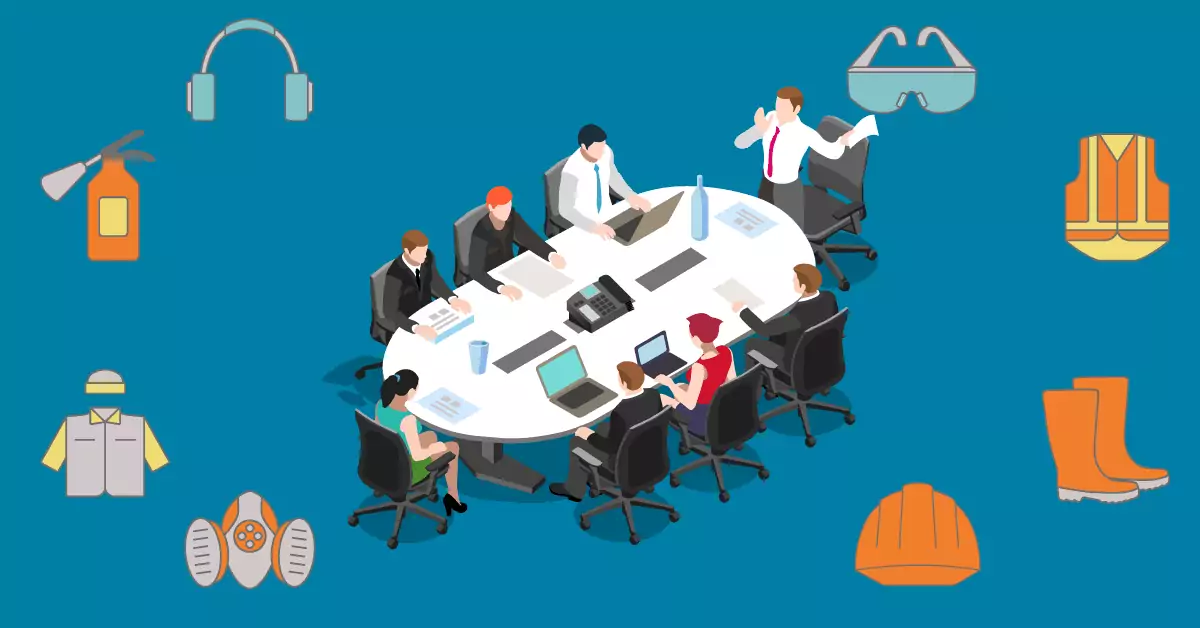
To run an effective workplace safety moment, try to:
- Engage your audience – A safety briefing, or moment at the start of a meeting, must be a two-way conversation between you and your workforce. Don’t talk at them; talk with them. Understand their concerns and give them a chance to ask questions.
- Not read manuals to them – Reading from a safety manual repels interest. It reflects your lack of preparation for a healthy and engaging discussion.
- Chalk out a time and place – It’s best to plan. Demonstrating what you are trying to teach works better, too.
- Discuss relevant safety issues – Don’t talk about topics that don’t apply to your work.
Safety and Industrial Engineering Consulting
As an industrial engineering consulting firm, safety is important to us at Vista Projects . Not only do we take every measure to keep our staff safe, we consider safety practices in our engineering designs. We believe safety in design is critical to the long-term viability of any facility. Sound safety practices also fit with our core values.
We believe all clients deserve:
- Transparency about projects and assets
- A collaborative problem-solving approach
- High-quality engineering designs
Simply put: the best interests of your project and asset are the focus of our multi-discipline engineering services . Contact us today to learn more .
Vista Projects is an integrated engineering The process of integrated engineering involves multiple engineering disciplines working in conjunction with other project disciplines to e… services firm able to assist with your pipeline projects. With offices in Calgary, Alberta, Houston, Texas and Muscat, Oman, we help clients with customized system integration and engineering consulting across all core disciplines.
Data-centric Execution

100+ Short Workplace Safety Topics from [A-Z] – Free Download
The human attention span has been dwindling since the mass-adoption of the Internet. No wonder it’s becoming more and more difficult to engage your workforce in safety training.
But that’s where short workplace safety topics come into play. With the right resources, they can be conducted several times throughout the week and last about 10-15 minutes. That’s enough to keep safety knowledge fresh on everyone’s mind and build the foundation of a strong health and safety culture. A culture in which your entire workforce is engaged and invested.
All great except… There is one challenge here. Quick safety talks can actually be more work because of the limited time. As Mark Twain famously said,
“I didn’t have time to write a short letter, so I wrote a long one instead.” Mark Twain
So, how do you make a short safety talk count?
The Short Safety Talks Secret: How to Effectively Communicate Workplace Safety Practices In Minutes
Good news! With the abundance of short safety topics that the Internet has to offer, you have just about enough resources to make even a 2-minute safety talk effective.
But before we get to the downloadable toolbox talk templates, here are a few tips on communicating safety best practices:
- Tell a story . According to cognitive psychologist Jerome Bruner, we are 22 times more likely to remember facts when they are presented through a story. Another study suggests that “telling stories when communicating can make the speaker appear more warm and trustworthy, as opposed to speaking some other way, such as providing only statistics and figures”.
- Stay focused on your topic . Yes, there are probably dozens of related things that you want to say. And they all seem important. But, if you want your safety talk to stick, you have to remain laser-focused on one specific topic.
- 5-10 slides max . You’ll probably want to keep a slide for about a minute. Keeping slide count smaller enables you to keep your toolbox talk short, too.

100+ Short Safety Talks For Work [A-Z index]
Ready to transform your workplace’s attitude towards health and safety? It’s easy to stay consistent with your safety talks when you have a reliable backlog of quick safety topics for you to choose from.
We’ve done the homework for you. Here are 100+ short safety talks, ready for when your next safety moment takes place. Hopefully, these will help keep your idea bank full for the foreseeable.
- 5 Examples of Unsafe Bad Habits
- Achieving your Team’s Health and Safety Goals
- Alcohol Awareness
- Allergies and Hayfever
- Attitudes to Workplace
- Health and Safety
- Back Stretches
- Being a Positive Influence for your Colleagues
- Being Proactive
- Bullying in the Workplace
- Burns and Knowing the Different Levels of Severity
- Carbon Monoxide
- Carcinogens
- Cell Phones as Dangerous Distractions
- Close Calls
- Communication
- Concrete
- Construction Sites
- Construction Surveying
- COVID-19 (we’ll cover this topic in more detail later)
- Cutting Down Complacency
- Deadline Pressures
- Defibrillators
- Dropping Heavy Objects
- Dust and its Hazards
- Electrical Safety
- Energy Drinks and Excessive Caffeine Consumption
- Establishing a Safe Working Environment
- Excavation
- Eye Damage and Eye
- Fall Protection
- Fall Prevention
- Feeling Immune – ‘It
- Wouldn’t Happen To Me’
- Fire Extinguishers
- Fire Safety
- First Aid Kit
- First Day Back
- Gasoline
- General Day-To-Day Safety
- Hand and Arm Protection
- Hand Tools
- Handling Chemicals
- Hazardous Substances
- Health and Safety Mentoring
- Heart Attacks
- Heat Stress
- Heavy Lifting
- Improving our Health and
- Safety Communication
- Keeping Everyone
- Accountable for Workplace Health and Safety
- Keeping Hydrated
- Ladder Safety
- Lead-Based Paint
- Learning From an Accident
- Lyme Disease
- Machine Guarding
- Meeting your Safety Goals
- Mental Health
- Mosquitoes
- Neck Stretches
- New Employees
- Noise and Noise-Induced Hearing Loss
- Office Safety
- Personal Hygiene
- Personal Protective Equipment
- Planning a New Task
- Potential Hazards
- Protective Clothing
- Radio Communication
- Reporting an Incident
- Reporting Injuries
- Responding to an Emergency
- Safety Paperwork
- Safety Signs
- Sleep and Fatigue
- Slips and Trips
- Snow and Frost
- Workplace Stress
- Teamwork and Our Health and Safety Culture
- The Common Cold
- Truck Driving
- Using New Equipment
- Water Safety
- Winter Safety
- Working Alone Safely
- Workplace Violence
For more inspiration, check out OSHA’s library of free safety training materials which include:
- Brochures/booklets;
- Fact Sheets;
- Guidance documents that provide detailed examinations of specific safety and health issues;
- Online Safety and Health Topics pages;
- Posters;
- Small, laminated QuickCards™ that provide brief safety and health information; and
- QuickTakes , OSHA’s free, twice-monthly online newsletter with the latest news about OSHA initiatives and products to assist employers and workers in finding and preventing workplace hazards.

Flu and Covid Toolbox Talks and Safety Moments
Given the current situation, it’s important to cover this particular safety topic in a bit more detail. Besides, speaking to your workforce about the risks presented by COVID-19, and how you can mitigate them, is a great topic for a quick, 5-minute safety topic.
Here are some of the points you can cover within this particular topic:
- Social distancing
- The importance of wearing a mask
- The main COVID-19 and flu symptoms
- What to do if you show any COVID-19 symptoms
- How often you should use hand sanitizer
- The best way to wash your hands
- Understanding the risks (including any key risks for your particular type of work)
- The current situation in the USA (legislation, statistics and changes)
- Examples of small changes that you can make to ensure your work practice is as safe as possible
You can pick and choose from any of these topics and adapt your safety discussions accordingly to best suit your workforce. As you can see, short safety talks are ideal for covering a health and safety concern of this kind in a way that is efficient, informative and as useful as possible for your workforce.
How Should You Document Safety Toolbox Topics?
Different document types have their own strengths and weaknesses. So, it’s worth considering what would be the right format to deliver your chosen topic.
In the table below, we’ve listed the document types that you can typically use, alongside their plus points and drawbacks.
How Often Should You Conduct Safety Talks?
In an ideal world, safety talks should take place daily. But this may be an unrealistic goal due to a Safety manager’s ever-increasing responsibilities. So, a good aim would be 3-5 short workplace safety topics a week. If your team is going through a busy period, you can also decide cut down the time that these talks last for. You can always find the time for a super quick 1-minute safety topic.
Where Should Safety Talks Be Conducted?
You should base these safety minutes in a place where everyone feels at-ease, while still firmly focused on what you’re saying. With this in mind, you could choose to have your next safety talk take place in a comfortable meeting room, a break room, or even the work area itself.
You don’t need to have a fixed location for these talks, either. The aim is to make them feel more informal and personal than a typical meeting. You can pick the location with the topic in mind. For example, if you’re talking about food allergies, the break room would make the message of your talk directly applicable to the day-to-day activities of your workers.
What Else Can You Do to Have a Better Safety Meeting?
Getting workers to listen for the entire duration of the talk is a challenge in itself. Not to mention getting them to actively relate to and understand the topic and then being able to apply the message to their own workplace behaviors.
To make your talk more engaging, try to interact with your audience directly. Encourage their participation, questions and feedback. Show them that this is not a lecture; it is a dynamic conversation that is taking place between the team as a whole. This way, you are helping to create a team that places the highest importance on keeping their operations as safe as possible.

Who Should Present a Safety Talk?
Normally, this would be the job of the team’s EHS manager. The presenter should be the individual who reports any incidents to OSHA. This way, it is the team member who is most well-versed in these topics who is delivering the content.
Does OSHA Require Toolbox Talks?
No. These talks are not a legal requirement of OSHA. The agency does not have a fixed standard in which safety training information needs to be communicated to a workforce. However, toolbox talks are a highly recommended way to advance your workplace’s health and safety beyond the bare minimum. Plus, the flexibility of these talks allows you to branch out beyond the topics that OSHA requires you to cover.
By incorporating regular safety talks into your workplace routines, you are putting your workforce in the best position to minimize preventable workplace accidents. Dedicating just a couple of minutes each day to a short safety moment will ensure maximum engagement in the topics being covered.
Also, these short safety topics for work help your team’s attitude towards health and safety and help improve your safety culture overall. This is far more intuitive and considerate than what could be achieved by a long meeting spent reading from a binder.
Additional Safety Moment Resources
If you’re keen to upgrade your workplace safety and the way that your team members discuss their practices, you can find more great resources below.
- Safety tips from eSafety : 8 Workplace Safety Tips Every Employee Should Know
- OSHA, Safe + Sound : Better Safety Conversations
- OSHA’s Safety Training page
- NSC : 2 Minute Safety Videos
- OSHA’s Training Requirements
Related Posts
8 important march 2023 safety topics to cover + spring safety tips, 7 interesting february safety topics to cover in 2023, 8 december safety topics for a safer holiday season at work.
Type above and press Enter to search. Press Esc to cancel.

An official website of the United States government.
Here’s how you know
The .gov means it’s official. Federal government websites often end in .gov or .mil. Before sharing sensitive information, make sure you’re on a federal government site.
The site is secure. The https:// ensures that you are connecting to the official website and that any information you provide is encrypted and transmitted securely.
Occupational Safety and Health Administration
- 中文(简体) (Chinese-Simplified)
- 繁體中文 (Chinese-Traditional)
- Kreyòl ayisyen (Haitian Creole)
- 한국어 (Korean)
- Español (Spanish)
- Filipino/Tagalog
- Tiếng Việt (Vietnamese)
- Outreach Training Program - General Industry
OSHA 10-Hour General Industry Outreach-Trainer Presentations
NOTE: The materials consist of PowerPoint ® presentations, lesson plans, and other relevant handouts. We encourage you to review these before you give a training presentation.
Download Zip Files: Due to the size of these files, it is recommended that you save them directly to your computer/device. Simply right click on the "Download" option and select the "Save Link As/Target As" and save as type Compressed (zipped) Folder (*.zip).
Outreach-Trainer Presentations
Introduction to osha.
One hour training component emphasizes workers' rights.
- Skip to primary navigation
- Skip to main content
- Skip to primary sidebar
- Skip to footer
SafetyRisk.net
Humanising Health, Safety and Risk
How to Give an Unforgettable Safety Presentation
June 3, 2019 by George Robotham 2 Comments
How to Give an Unforgettable Safety Presentation (Failure is not an option)

The following has been assisted by formal learning / Education but largely represents critical reflection on the writer’s personal practice. The people who say an amount of it is based on the writer’s stuff-ups would be quite correct
- The number one thing you must do is identify your audience’s needs, the number 2 thing you must do is satisfy those needs
- “When reading your correspondence the reader must say “Wow” in the first third of the page”
- “When listening to your presentation the listener must say “Wow” within the first 3 minutes”
- Most of us are not naturally gifted speakers and need some assistance to make an impact. The following will make your presentation unforgettable-
- Do not focus on what you are going to talk about but focus on your outcomes, objectives and end results (What you have achieved for the participant)
- If you want to get exposure as a speaker volunteer
- Preparing a speech-Talk to the audience first, demonstrate an unique perspective, orientate to the future, be provocative , use relevant aids, let your audience know you have done your homework
Getting relevant input for your speech, ask 3 questions-
- What is the biggest challenge you are facing in your job?
- If you could change just one thing tomorrow what would that be?
- What advice would you like to give a new person in your job?
- Preparing a speech-Outcomes, time frame & requirements, key learning points, rough draft, supporting stories, aids and examples, build the opening and conclusion ,practice the speed and adjust the timing.
- Need to define and articulate how you will improve the participants condition.
- .The key to a successful presentation is identifying and meeting the needs of your audience. You need to define your objectives and the desired outcomes.
- Have a variety of presentation styles to cope with differing learning styles.
- It helps to appeal to your audiences emotions-Power, pride, courage, self interest, convention, posterity, sociability
- Use clear, simple messages
- Good visual aids are clear, simple, original, easy to see, easy to grasp, stimulating, creative, reinforce your messages
- Good messages will trigger an emotional response
- Use facts to support your message but do not use facts as the message
- Super prepare for an important presentation, particularly rehearse your opening & conclusion so it comes out strong & clear
- Sometimes some comment on why you are qualified to talk on this topic is appropriate
- At the beginning tell them what you are going to do and how you will do it.
- Research the topic thoroughly bearing in mind that not everything you find on the internet will be credible. As well as looking at the theory it helps to talk to people who have practically implemented strategies.
- Throw in a bit of humour
- Have an interesting anecdote that touches the emotions of my audience. The following is something that got me a lot of applause with a Canadian audience on a talk about safety
- Hold up an Australian $ 100 note (worth about $95 Canadian)
- “Who would like me to give you this $ 100 note?
- Show of hands
- Crumple it up
- Who would like me to give you this $ 100 note?
- Stand on it, jump on it and grind it into the ground
- That right, it still has value despite what has been done to it and many people want it
- YOU are like this $ 100 note, throughout your life trying to improve safety there will be many people who put you down and try to grind you into the dirt
- Remember that YOU, like the $ 100 note still have value despite what others have tried to do to you and many people will want you.”
- Note The storey above is adaptable to a wide range of situations with a bit of thought and adaptation
- Know your audience, know their needs and fill those needs
- Have a strong opening and conclusion
- Make a conscious effort to slow down your speech to slightly slower than normal conversation
- Use a few Power-Points but not “Death by Power-Point”. Make the size of the font readable down the back of the room. A lot of people get annoyed if you stand in front of them and read out what they can easily see on the screen. A bit of clip art and colour helps to liven up the power-points. Leave your power-points on screen long enough to be read.
- Try to build in a range of activities for the participants that reinforce your message. A controversial question for discussion is sometimes useful
- Rehearse your presentation sufficiently that you do not have to refer to your notes too often, you thus maintain eye contact with your audience.
- Make it fun not hard work
- Treat your audience with respect
- Do not try to cram too much information into too short a time frame, people will become overloaded & give up. Concentrate on the MUST KNOWS
- Have learning objectives and plan to meet those objectives
- Avoid lecture style presentations where you read from your notes unless the presentation is very short, suggest a maximum of 5 minutes. Instead prepare speakers notes ( big enough for you to read them in poor light) with key points and talk to the key points, this will require a bit of rehearsal. Alternatively use the key points on your power point presentation as your notes, pays to have the hard copy notes as a back up just in case for a number of reasons that could crop up when you rely on technology, you cannot use the power-points.
- Sometimes a “Where to from here” is appropriate at the end
- If time permits encourage questions
- Always pilot your presentation and react to comments
- The idea is for the audience to get lost in the topic, give them word pictures they can relate to
- Give something of yourself eg. a personal storey, to build rapport with the audience
- Focus on audience needs and use words appropriate to those needs
- Always identify the range of the audience and target your presentation appropriately
- Identify the purpose of the presentation and the one, single message you want to transmit. Paint a picture to give the message
- A good approach is to make a point and then tell a storey about that point or tell a storey to make a point. Indigenous people are good storey tellers and this is a powerful technique.
- Use pauses and silence to emphasise points
- Have links between sections so audience can see where you are going
- If you have practical exercises that require participants to give feedback have a roving microphone person.
- Check out the venue beforehand in case any adjustments to your presentation are required.
- Try to get the audience close to you.
- Go along and see learn how the professional speakers do it-For me Laurie Lawrence, Nick Farr-Jones and General Norman Schwarzkopf were fantastic and could be learnt from.
- The presentations that seem so easy and natural only got that way through lots of work, rehearsal and preparation.
- Do not be surprised that you have to spend 5-10 times in preparation as presentation.
The Use of Humour
- Laughter is the best medicine!
- Much is written about the benefits of humour, you can look it up on the internet if you like. I will not mention this here as I am sure you will have a good intuitive idea of what I am talking about.
- In the days when I used to work in the mining industry I remember being in a meeting in Rockhampton about a series of personal damage occurrences (“Accidents”) that had occurred. Two representatives of the company that manufactured the equipment involved were in attendance along with a number of industry Safety Advisers. The manufacturer representatives would not acknowledge that the design of their equipment was a factor and were spinning us their company line about how safe their equipment was. Tempers progressively got more frayed and we were getting nowhere. My workmate Terry Condon came out with a classic, humorous one-liner that defused the tension and set the scene for meaningful progress.
- That was the first time I have seen humour used in a meaningful way in business. I watched Terry in action after this and noted his frequent effective use of humour.
- Humour can be used effectively in formal and informal presentations and in general interaction in business and non-business life.
- Avoid humour that focuses on religion, politics, race, class, sex, age, physical appearance. To use any of these will run the risk of upsetting someone. I hear you asking what the hell else is there that I can use? The only safe butt of your humour is yourself! You can also use mythical people whose characteristics you do not describe.
- There are joke books you can buy but storeys from daily life are more acceptable.
- Be funny early and often.
- Introduce the humour in the general flow of your conversation.
- For a major presentation rehearse and listen to yourself on a tape recorder.
- Like many things in life humour follows the 6 P rule-Prior Preparation Prevents Piss-Poor Performance.
- If giving a major presentation have a small pilot first and respond to the comments you receive.
- Try to use humour that relates to things others see as an annoyance.
- Know your audience and try to relate to them.
- Quotations from famous people are often sources of humour, you can search these on the internet, Laurie Lawrence’s web-site has a lot of quotations.
- Stretching the truth is forgivable.
- Do not take yourself too seriously.
- You can use a storey to illustrate a point.
- The Readers Digest and t.v. comedy shows are good sources of material. It also helps you to observe how the professionals use humour.
- Poking fun at the establishment may be an appropriate and inoffensive way of using humour.
- Appropriate self-disclosure can be an effective way of enhancing communications and interpersonal relationships. I was introduced to and practised appropriate self-disclosure in a Psychology subject. You will find in a new relationship if you reveal a little bit of you (provided it is appropriate)the other party will reveal a little bit of them(provided it is appropriate), if you then reveal a little bit more of you(provided it is appropriate) they will reveal a little bit more of them (provided it is appropriate), and so the cycle goes on. This is very simple, incredibly effective and I use it all the time to build relationships. Of course if you really hang all your dirty washing out it will probably stuff up the process.
- Telling a humorous storey about yourself can be a great way of starting the appropriate self-disclosure process. If you show you are prepared to pile crap on yourself it will influence how you and your message are perceived.
- Being an OHS person I attend a number of safety conferences and courses, these are inevitably dull, dry and boring affairs. It is a pity things are taken so seriously! Perhaps the same thing happens in your speciality? If you are a presenter who uses effective humour, presents well and has a relevant message you will be invited back.
The presentation secrets of Steve Jobs (Ex-C.E.O. of Apple)
- Transmit passion for your topic
- Write out the 3 key messages you want your audience to receive
- Offer evidence or testimonials, have third party reviews
- Use video where you can
- Early up answer the question about why your audience should care
- Rally people to a better future
- Use groups of 3 rather than long lists of topics
- Introduce an antagonist, reveal the conquering hero who makes life better
- Give an experience not a presentation
- Your audience checks out after 10 minutes, give them something different or something to do
- Keep it simple
- Use photos wherever possible
- Paint a picture, the more strikingly visual your presentation the more people will remember it
- The brain switches off to boring things, use variety
- Deliver what you promise
- Give credit to your helpers
- Use demonstrations
- Reveal a Holy S # 1 t moment
- People remember how you made them feel not what you said
- Use a minimum of notes so you maintain eye contact with the audience
- It only looks effortless when you put in a hell of a lot of practice
- Try to anticipate questions
- Relentless preparation is the way to beat nerves
- Never read out a prepared speech
- Latest Posts
- More about George

George Robotham
Latest posts by george robotham ( see all ).
- Psychology and safety - February 19, 2024
- Psycho-social workplace issues - February 6, 2024
- Psychometric Testing and Safety - January 13, 2024
- Icebreakers and Games that Safety Trainers Play - September 8, 2023
- “Risk Makes Sense” Book Review - June 29, 2023
Please share our posts
- Click to print (Opens in new window)
- Click to email a link to a friend (Opens in new window)
- Click to share on LinkedIn (Opens in new window)
Reader Interactions
Ndilimeke Shiwayu says
May 25, 2022 at 12:07 AM
I would like to get example of safety presentation
Rob Long says
May 25, 2022 at 4:54 PM
If you need to be spoon fed on how present, then you will never present well.
Do you have any thoughts? Please share them below Cancel reply
Top posts & pages. sad that most are so dumb but this is what safety luves.
- CATCHY and FUNNY SAFETY SLOGANS FOR THE WORKPLACE
- 500 of THE MOST EFFECTIVE HEALTH and SAFETY SLOGANS 2024
- Free Safety Moments and Toolbox Talk Examples, Tips and Resources
- FREE RISK ASSESSMENT FORMS, CHECKISTS, REGISTERS, TEMPLATES and APPS
- Injury Data and Statistics Spreadsheet
- How to Calculate TRIFR, LTIFR and Other Health and Safety Indicators
- Icebreakers and Games that Safety Trainers Play
- Safety Poems by Don Merrell
- Technique and the Demise of the Agile, Scrum Myth
- Free Risk Assessment Template in Excel Format
Recent Posts
- Sacred Objects to Remember Un-Safety
- Perfectionism in Safety and the Denial of Humanity
- Understanding Mythology, Myth, Mythosphere and Science – A Podcast.
- Dumb Ways to Discourse, a Failed Approach in Safety
- Sifting the Chaff from the Wheat in Safety
- Enrol in First Course in Safety Engineering with Dr Barry Spud
- Safety, The Expert in Everything and the Art of Learning Nothing
- More of the Same Expecting a Different Outcome in Safety
- Do you know how to sell safety?
- ‘False Consciousness’ and Perception in Risk and Safety
- Dumb Safety Slogans and Myths
- A Tale of Two Worlds in Safety
- No End of Heaven nor Scientific Age for Safety
- The Seduction of Measurement in Risk and Safety
- What’s Faith Got To Do With Safety
- Punking Safety, When It’s Not.
- SPoR International Convention 13-17 May 2024 – Canberra
- Three Cheers for the Safety Saviours
- Risk & Safety. IQ – EQ – iCue
- King of the World – Why is Sociopathy and Psychopathy so prevalent ‘at the top’?
- Shame and Blame as Social Semiosis
- The Metaphysics of Safety
- Human Dymensions Newsletter–Feb 14
- The Problem of Blame for Fallible People
- The Theology of Blame from Safety Science
- Everyday Social Resilience, The Semiotic Wave
- Zero, The Recipe for Anxiety, Fear, Shame and Blame
- Ditch the Swiss-Cheese if You Want to Understand Causality
- No ‘Taming’ or ‘Fixing’ Wicked Problems
- Book Launch – Everyday Social Resilience, Being in Risk
- Change in Safety and Cognitive Dissonance
- Preventing Mistakes, Ooops! DROPS!
- Workshops Dr Nippin Anand – Hong Kong, Singapore, Canberra, Melbourne
- Don’t look Now, Your Slogan is Showing
- What’s the Safety Idea, What’s the By-Product?
- Risk Aversion is Life Denying
- Real Risk, Human Discerning and Risk
- Safety Culture Silences – Power
- CLLR Newsletter – Education and Learning Special Edition – Approaching Events
- What is Education in Risk?
- SELLING SAFETY TO YOUR GM
- Warped Imagination and Magical Thinking in Risk and Safety
- The Tyranny of Absolutes
- Global Conference in SPoR – 13-17 May 2024 – Canberra
- Allostasis and Homeostasis in Risk
- Book Launch – Dr Robert Long – Real Risk Book Three
- What Can Safety Learn From Addictions?
- Error Trajectories and Risk
- A Change of Heart and Worldview
VIRAL POST!!! HOW TO QUIT THE SAFETY INDUSTRY

FEATURED POSTS
Look with your heart and not with your eyes, desensitisation–the by-product of ill-conceived safety initiatives, you don’t want a compliance culture, be alert, safety needs more lerts, compliance, obedience and the attraction of risk, looking for another side, understanding conscience and safety, consciously safe, unconsciously unsafe or head in the sand safety, i just don’t know, how groupthink works, in praise of balance in risk and the threat of extremism, by what method, question for the safety thinkers, coronavirus and the dunny paper effect, talking risk video–the unconscious in communication, holistic responses to mental health, what is spor, something different to safety, mental health, risk and safety – part 2, no hope for safety, the language of priorities, having meetings without ‘meeting’, centre for leadership and learning in risk (cllr)–study calendar, the worm at the core, non-binary decision making in risk, social sensemaking – book launch dates & venues confirmed, making safety better by using our adaptive toolbox, what’s the alternative to traditional safety spor., toilet roll safety, the illusion of hazard identification, how workers really make decisions, i’ve got a feeling this isn’t right, but….., diagnosing safety, psychometric testing and safety, making the world fit the safety worldview, the psychology of blaming in safety, icue listening engagement manual, second group completes graduate certificate in psychology of risk, how do we mourn, off to a flying start in learning with cllr.
More Posts from this Category
VIRAL POST – The Risk Matrix Myth
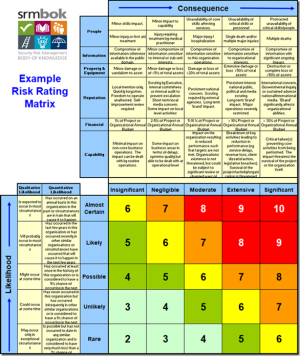
Subscribe to Blog via Email
Enter your email address and join other discerning risk and safety people who receive notifications of new posts by email
Email Address
WHAT IS PSYCHOLOGICAL SAFETY?
What is Psychological Safety at Work?
Psychosocial Safety and Mental Health Series
Burnout, distress and role conflict in safety, are you at-risk of burnout in safety, psycho-social workplace issues, ai priorities and the creation of psychosocial harm, don’t be obsessed with safety, a guide to psychosocial safety skills, mindfulness is not brain-fullness and other psychosocial myths, have you had a drink of safetea, if you can’t manage fallibility, you’ll never tackle psychosocial health, embodiment, myth and psychosocial risk, discover more from safetyrisk.net.
Subscribe now to keep reading and get access to the full archive.
Continue reading
Got any suggestions?
We want to hear from you! Send us a message and help improve Slidesgo
Top searches
Trending searches

teacher appreciation
11 templates

cybersecurity
6 templates

spring season
34 templates

archaeology
45 templates

46 templates

23 templates
Workplace Safety Training Workshop
Workplace safety training workshop presentation, premium google slides theme and powerpoint template.
Safety always comes first. That’s why preparing a workshop for safety training in the workplace for new hires is a vital thing to do! No matter what kind of job you have, if it’s in an office or outdoors, you always need safety training. These slides will help you prepare a slideshow for your co-workers and ensure you that they are aware of all the dangers their workplace has and how to avoid them!
Features of this template
- 100% editable and easy to modify
- 29 different slides to impress your audience
- Contains easy-to-edit graphics such as graphs, maps, tables, timelines and mockups
- Includes 500+ icons and Flaticon’s extension for customizing your slides
- Designed to be used in Google Slides and Microsoft PowerPoint
- 16:9 widescreen format suitable for all types of screens
- Includes information about fonts, colors, and credits of the resources used
What are the benefits of having a Premium account?
What Premium plans do you have?
What can I do to have unlimited downloads?
Don’t want to attribute Slidesgo?
Gain access to over 22700 templates & presentations with premium from 1.67€/month.
Are you already Premium? Log in
Related posts on our blog

How to Add, Duplicate, Move, Delete or Hide Slides in Google Slides

How to Change Layouts in PowerPoint

How to Change the Slide Size in Google Slides
Related presentations.

Premium template
Unlock this template and gain unlimited access

Sign up free
10 Safety Topics for Work
February 5, 2024
Jeanellie Avelino
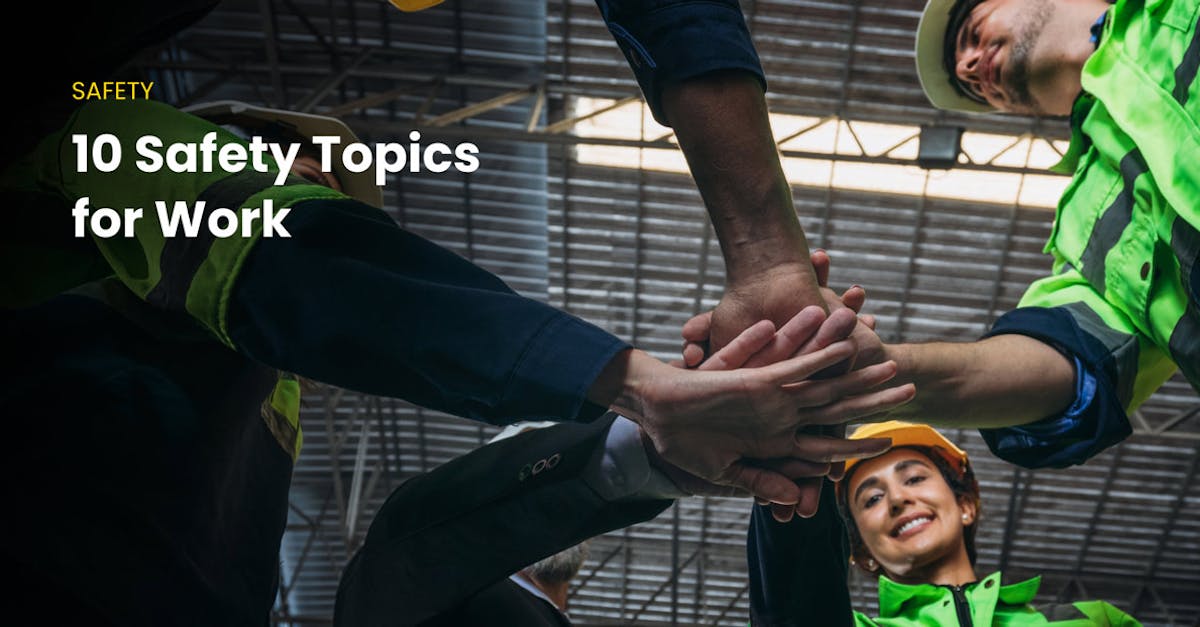
Raising awareness of the most relevant safety topics for work is the key step in fostering a safe and healthy workplace culture and environment. Whether your employees work on a construction site or spend long hours at an office, they must be constantly alert and aware of the inherent dangers in their surroundings.
To help you out with your research, we’ve selected 10 safety topics for work that you can incorporate into your training program.
What are safety topics for work?
Safety topics for work refer to the various safety aspects that employees need to be aware of to protect themselves and their colleagues from harm in the workplace. Depending on the industry you’re in or the type of work being done by your team, it’s up to you which safety meeting topics you want to prioritize.
Fire safety, electrical safety, ergonomics, personal protective equipment (PPE), managing hazardous materials, and preventing workplace violence are just some of the most common safety topics at work. To maintain a safe and healthy workplace, it is the responsibility of both you and your employees to see to it that these safety topics are understood and followed.
1. Slips, trips, and falls
Slips, trips, and falls occur more than one might anticipate at work. According to the Bureau of Labor Statistics, they account for nearly 700 incidents per year , resulting in workplace injuries like cuts, bruises, and fractures, and more fatal consequences such as impairment of the spinal cord and nervous system. The most common factors in these incidents are wet and slippery floor surfaces, poor lighting, unsuitable footwear, and unstable walkways.
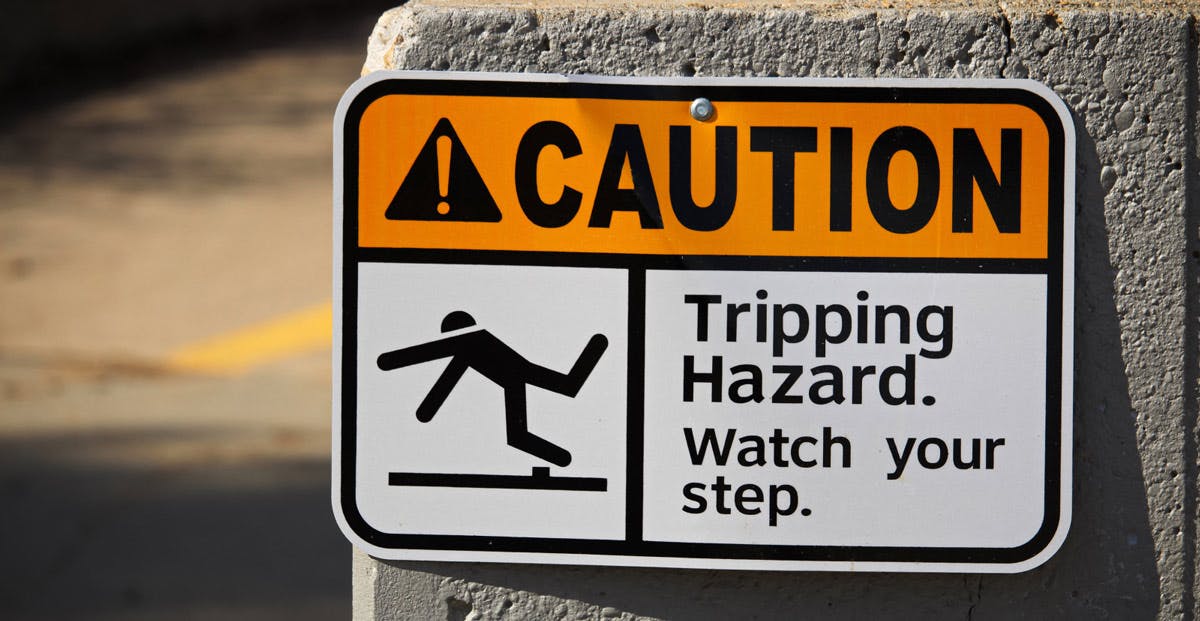
While you may be imagining them in more hazardous job sites like construction and manufacturing facilities, slips, trips, and falls can also happen within the four walls of your office space—either tripping over a box or slipping on a newly mopped floor.
Raising this safety topic for manufacturing , construction, or sports activities safety meetings and giving learning resources like fall protection training courses will alert your employees on the most common slip, trip, and fall hazards, like where and how they can occur, and from there, follow the right precautionary steps to minimize and eliminate the risks.
Recommended online resources on slips, trips, and falls:
- Safety in the Workplace by SC Training
- Ladder Safety by SC Training
- Slips, Trips & Falls by High Speed Training
- Slips, Trips and Falls by Aveling
2. Proper use of Personal Protective Equipment (PPE)
Personal protective equipment (PPE) refers to specialized clothing and equipment that protect industrial workers dealing with hazardous chemicals , heavy construction materials, loud equipment, and also health care providers working around patients exposed to potentially infectious diseases.

If your business falls under any high-risk industry requiring the use of such protective equipment, it is integral that you keep open communication with your team and discuss with them the specific type of PPE they need for their job, as well as its correct use, storage, and maintenance. You can do this through safety talks, safety briefings, or even short safety presentations.
Plus, you must also educate them on the core reasons why they need such protection for their job and the health and physical risks of not following the right way of wearing and using their PPE. This safety topic for work isn’t only relevant upon onboarding, but it should be discussed regularly among your existing employees.
Recommended online resources about Personal Protective Equipment (PPE):
- Personal Protective Equipment (PPE) for Construction by SC Training
- Personal Protective Equipment by eSafety
- Introduction to Personal Protective Equipment (PPE) by Safetyhub
3. Workplace Ergonomics
Workers in physically demanding industries like manufacturing, retail, and services perform strenuous and repetitive tasks like lifting, assembling, pulling, and bending. Without proper ergonomics practices, these tasks may result in fatigue and discomfort, leading to frequent body aches and pains, and sometimes even musculoskeletal disorders or permanent disabilities.
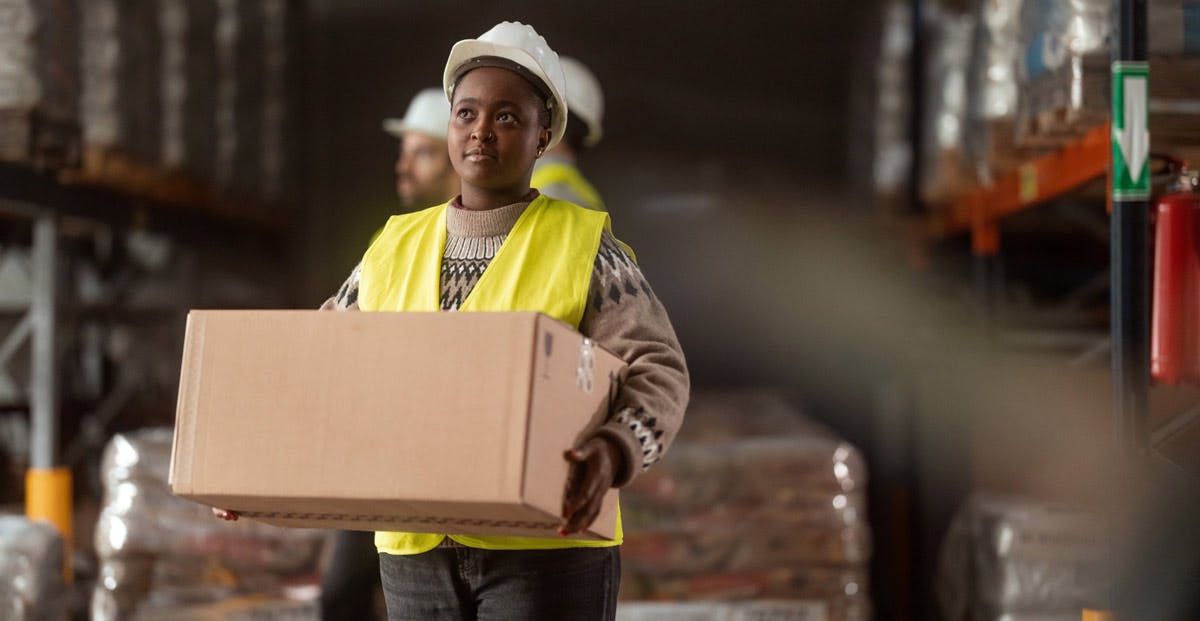
Establishing good ergonomics in your workplace—like using devices and equipment for lifting and transporting heavy materials, installing anti-slip and anti-fatigue mats, or changing tables and chairs’ positions to improve posture—goes a long way in lowering the chances of injuries and at the same time improving their daily productivity. These practices must be communicated clearly with your workforce to ensure effective reinforcement and implementation.
Recommended online resources and safety topics for meetings about workplace ergonomics training :
- Ergonomics for Manufacturing by SC Training
- Ergonomics for Retail by SC Training
- Ergonomics Training by Sentrient
- Office Ergonomics by Choice Training & Consultancy
4. Drugs and Alcohol Misuse in the Workplace
Drugs and alcohol can impair your employees’ physical and mental state, causing a wide array of problems at work, like loss of production, absenteeism, and worse, fatalities and accidents.
Hosting a training program or seminar on this safety topic for work will help open their minds about the physical and health risks of these substances, as well as encourage them to become more responsible in building a safe, drug-free environment. Maintaining responsible behavior at work will result in higher productivity and work quality with fewer injuries—a win-win situation for both the company and the employees.
Recommended online resources about drugs and alcohol misuse:
- Drugs and Alcohol in the Workplace by SC Training
- Drug and Alcohol Awareness by Emtrain
- Drug and Alcohol Prevention at Work by Everfi
5. Road and Driver Safety
While it’s nearly impossible to promise 100% safety on the road, you can always reduce the odds of accidents by increasing your team’s knowledge about the most common road hazards and the safest practices that they can adopt while driving.
Tackling this safety topic for work is even more crucial if you are managing transport and shipping truck drivers , who are mandated to expedite products and services in the quickest but safest way possible to satisfy customer demands . It is crucial to educate your drivers about the trucks they are driving and the pickup parts they are using for the safest service possible.
For your road safety training, you can talk about the techniques and strategies of defensive driving to urge your workers to drive more safely around other vehicles. You can also roll out quizzes and assessments that will refresh their mind with the basic traffic rules and regulations, ensuring a safe journey while on the road. You can also highlight the grave consequences of reckless and drunk driving so they can commit to smarter and safer driving.
Recommended online resources about road and driver safety:
- Driver Safety by SC Training
- Defensive Driving for Heavy Vehicles by SC Training
- Extreme Weather Driving Training by REED
6. Electrical Safety
While it’s needless to say that addressing electrical safety hazards is crucial for electricians, construction workers, mechanics, and many others in similar fields, this safety topic for work will also benefit those concerned with office workplace safety. Even more so these days, wherein most work activities are heavily reliant on gadgets, tools, and equipment, which operate on electricity.
All are aware of how damaging electrical incidents can be—live wire contacts can cause electric shocks leading to cardiac arrest; electric short circuits and overheated wires can trigger a fire easily; and an arc flash can result in burns, blindness, and hearing loss. Still, they can be prevented if your employees are well-versed in basic safety measures, especially when working around electrical equipment, and the right steps to follow when responding to any related emergencies.
Recommended online resources about basic electrical training :
- Electrical Safety by SC Training
- Controlling Hazardous Energy: Electricity by SC Training
- Basic Electricity by 360training
- Basic Electronics and Electricity Course by TPC Training
7. Fire Safety and Evacuation Plans
Unfortunately, no industry is exempt from fire hazards. From loose wires and overloaded plugs in office rooms to improper storage of combustible materials in manufacturing facilities, a fire breakout can occur anytime and anywhere. Without a proper fire and emergency plan in place, this event can cause catastrophic consequences such as property damage, burns and injuries, and worse, even death. Moreover, if your building has a door access control system in place, employees need to be trained on how to use this system during an evacuation or when there is a fire danger.
Having an organization capable of identifying and mitigating fire hazards is your key step towards fire prevention. Every now and then, it will be helpful to refresh their minds on the basics of fire safety , the precautions they need to take, and the right use of alarm systems and fire extinguishers. It’s also a good idea to create an emergency action plan beforehand and make sure that your team is fully prepared for its execution. This way, you can rest assured that they know exactly how they should respond and how to observe an orderly evacuation in case of a fire breakout.

All fire department members are committed to protecting their fellow citizens in times of need. Not only can they fight fires, but they can also work to prevent other disasters from causing unnecessary loss of life and property. It is also the responsibility of firefighters to assist in the event of other disasters. In collaboration with other emergency response agencies, firefighters protect personal safety, save lives, save property, and protect the environment, accomplishments that are often recognized with personalized coins.
The fire department challenge coins are small but very solid. What better souvenir for a firefighter than a Firefighter Challenge Coin? A Firefighter's Challenge coin stays with them throughout their tenure as a testament to their contributions to the community. The meaning it represents is priceless!
Recommended online resources and oil field safety topics about fire safety and evacuation plans:
- Fire Safety by SC Training
- Fire Protection by SC Training
- Evacuation Plan by SC Training
- Fire Prevention Plans by OSHAcademy
- Fire Emergency Evacuation Procedures by Safety Services Direct
8. The Basics of First Aid
In its most basic form, first aid is initial emergency care given to an ill or injured person, just until a professional medical service arrives in place. It can help save lives, hinder temporary and long-term disabilities, and prevent any emergency from becoming worse. With this in mind, it makes a good business strategy to train your employees on the basics of first aid and EMS training as it will help you secure a healthier, safer workplace environment for your workers.
Some of the most useful first aid procedures that you can include in your safety training are treating bleeding and fire burns, carrying out CPR (Cardiopulmonary Resuscitation), nursing a person who has fainted, and responding to sprains and bone fractures. It is also worth discussing how they can perform assessments and file incident reports whenever needed.
Recommended online resources about first aid training :
- The Basics of First Aid by SC Training
- Workplace First Aid Online Training by High Speed Training
- CPR, AED, and First Aid by Alison
- First Aid at Work by Echo3
9. Fatigue & Stress Management
Another safety topic for work that is worth discussing with your team is coping with fatigue and stress management. Living and working in a fast-paced world with incredibly high customer and client demands, fatigue and stress have been a common and unfortunately normalized problem in the modern industry. They are, in general, the result of skipping lunch breaks and missing days and weeks of sleep due to long duty periods, heavy workloads, and cranky deadlines. If not immediately addressed, they can impair cognitive and body functioning, sometimes even permanent impairment, and long-term mental problems, like anxiety and depression.
But fret not, achieving a healthy, low-stress work environment is feasible. Regularly reminding your employees of the common causes of work stress and fatigue and their implications for their mental and physical state is a strategic place to start. You may also want to consider sharing with them some learning materials and resources to help them develop positive coping strategies and some relaxation techniques to reduce strain and stress.
Recommended online resources about fatigue and stress management:
- Fatigue Risk Management by SC Training
- Managing Leadership Stress by SC Training
- Stress Management – Techniques for Coping with Stress by Alison
- Stress and Fatigue in the Workplace by Besafe Training
10. COVID-19 Awareness and Preparedness
Last but not least in this list is increasing your organization’s awareness about COVID-19 and improving their preparedness and response action. According to experts, among the best ways to reduce the chances of coronavirus infection is to provide your team with reliable and accurate information about the virus, like how it spreads and what symptoms to look out for.
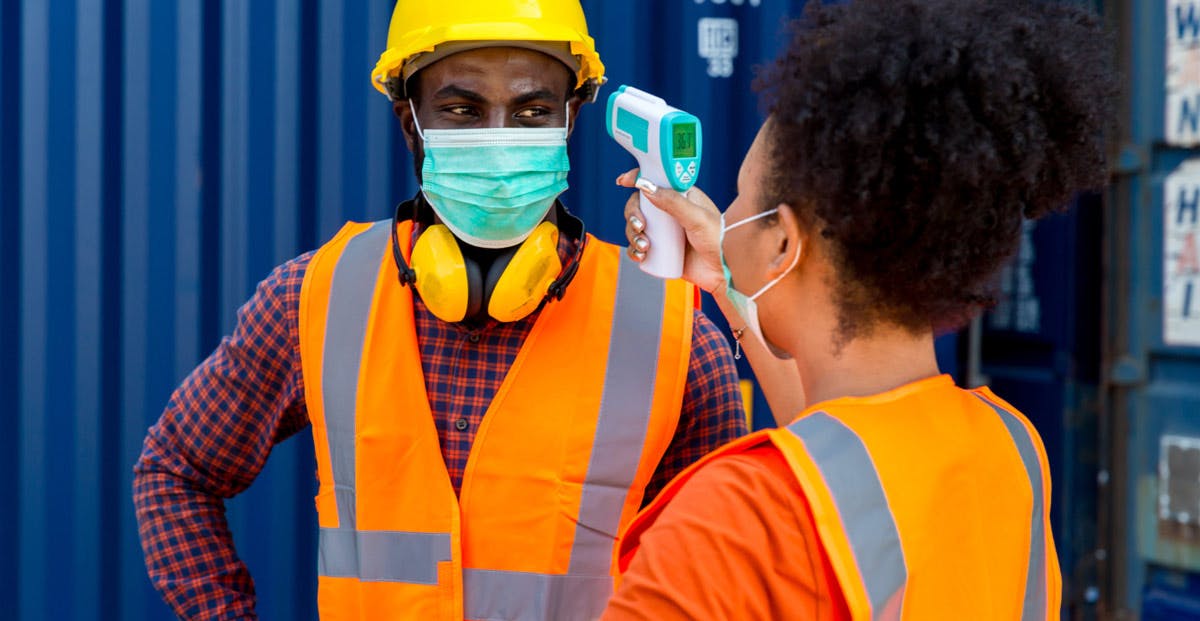
If your workforce is finally returning to work, it is also recommended to discuss with them the guidelines and safety measures set by the World Health Organization (WHO) and Centers for Disease Control and Prevention (CDC). It’s also crucial that they’re given clear instructions on what to do if someone on the team gets sick with the new coronavirus.
Recommended online resources for COVID-19 training :
- Let’s Kick COVID-19! by SC Training
- Combating the Disinfodemic: Working for truth in the time of COVID-19 by SC Training
- COVID-19 Preparedness and Response: Good Practices and Precautions when Using Breathalyzers by SC Training
- Covid Training Course (COVID-19) Coronavirus Essentials by Grey Matter Learning
- Understanding the COVID-19 Pandemic by Johns Hopkins University Experts
Safety Topic of the Day
To increase accuracy and efficiency in tasks like lifting and carrying bulky goods, heavy machinery is utilized in sectors like construction, manufacturing, and shipping. Heavy equipment includes large machines and vehicles including cranes, forklifts, bulldozers, and many others.
Because of how dangerous these equipment and vehicles are, operating them or being near them places a great deal of responsibility on the shoulders of personnel. It can result in accidents or even fatalities if you don’t know how to use them safely.
Go beyond simple safety topic talks
Although, it's everyone's responsibility to emphasize the importance of safety at the workplace, funny safety topics are a great way to break the ice during toolbox talks. Consider compiling and sharing funny safety moment topics without ever taking workplace safety lightly. Just a great way to keep your employees engaged with training.
Promote workplace safety with Training by SafetyCulture
Free online learning platforms like SC Training offer an easy way to put together 5-minute safety topics for work and share the content with your team. Thanks to their responsive authoring tool and microlearning templates, all you need to do is copy and paste your workplace safety content or import your existing training materials, hit publish, and you’re all good to go.
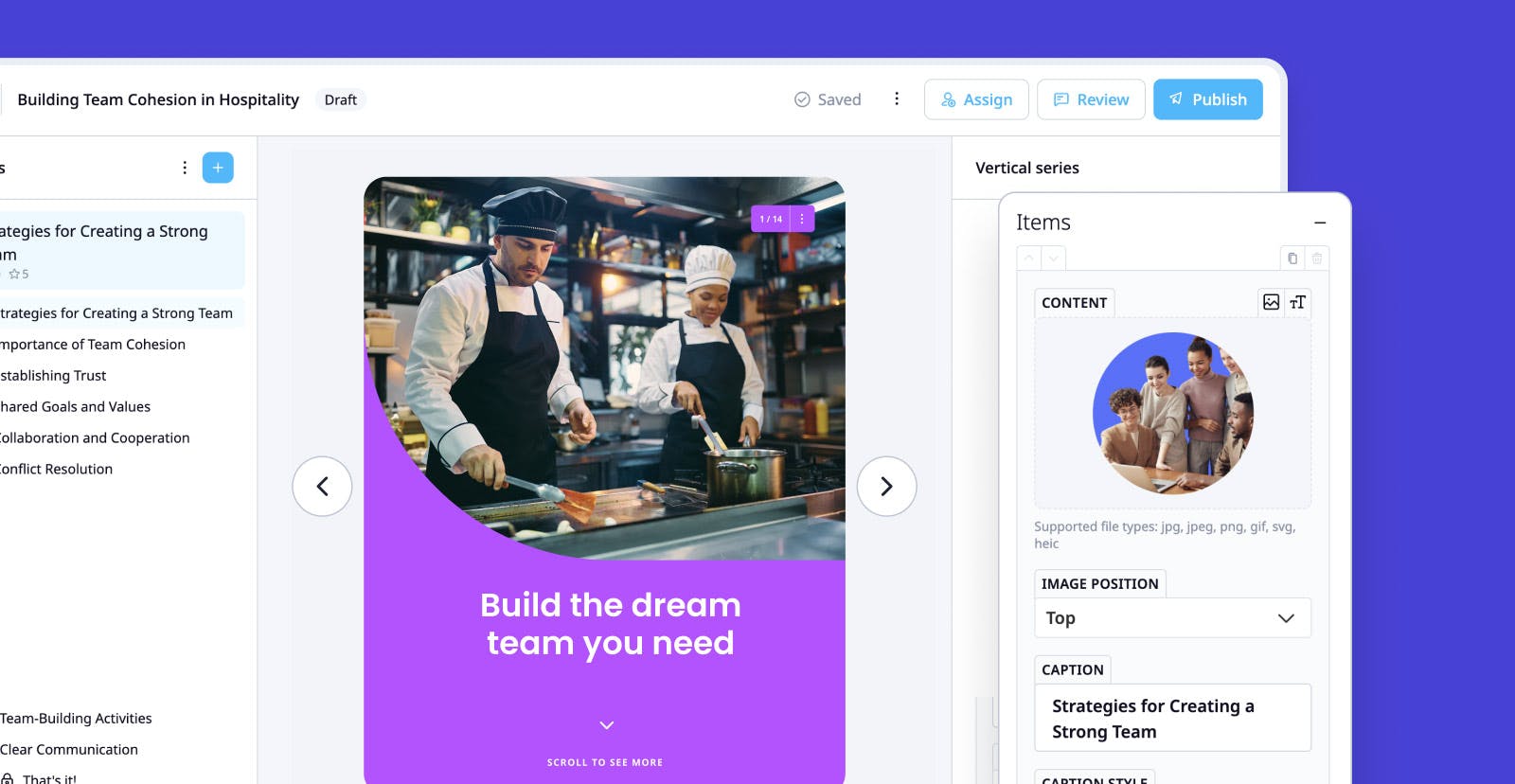
With SC Training, you’ll also discover a comprehensive e-learning course library of beautiful, world-class learning resources, created in collaboration with some of the most reputable brands and thought leaders in the world. There are courses about safety ladder safety, electrical safety, PPE use, and even other safety topics like food safety hazards, food contamination training courses, and more.
They are structured into topical, bite-sized chunks, enhanced with powerful features like gamification elements and an online quiz maker to improve the learning experience of your employees. This platform has also made most of their courses editable so that you can easily edit, rebrand, and personalize them with ease.
To reiterate, there are several opportunities to communicate hazards in the workplace and safety practices to your team:
- Set up a meeting or a conference
- Host a webinar or online training if you’re handling a remote team from different parts of the world
- Roll out e-learning or mobile training courses
- Organize blended training (a combination of traditional face-to-face and online training)
However, keep in mind that the success of your safety awareness training or program doesn’t solely depend on your training delivery method. You also need content that will not only engage your employees but also offer them exciting learning opportunities. This way, they can deter complacency and avoid common safety-related workplace incidents and injuries from occurring.
A great way is to use engaging learning content and topics. You can even mix it up with funny safety talks and funny safety presentations. Although safety isn't a joke, integrating some funny safety topics for work can help normalize safety culture at your workplace.
Start using the best safety training platform today! Sign up for free.
Subscribe to our blog newsletter
Jen is a learning expert at EdApp, a mobile-based training platform that helps corporates and businesses bring their training solutions to the next level. She carries an extensive writing experience in a variety of fields, including architecture, the gig economy, and computer software. Outside of work, she enjoys her free time watching her favorite series and documentaries, reading motivational books, and cross-stitching.
Explore more
Explore case studies
Learn how customers like you use EdApp. Their results speak for themselves.
Book a demo
Get a tour of our core products and features with one of our experts.
Take a bootcamp
Instantly access our video library updated weekly with live demonstrations.
Check out G2 reviews
Don't take our word for it. Here’s what our customers have to say.

IMAGES
VIDEO
COMMENTS
Here are 12 great safety presentation ideas you can use in your workplace. Click on each idea to learn more. How to prevent slips, trips, and falls How to respond to hazardous spills How to stay safe when working on an elevated work platform How to prevent workplace violence and harassment
A safety moment is a brief talk about a specific, safety-oriented topic at the beginning of a meeting. A safety moment is usually between 5-10 minutes long and may also be called "safety minutes," "safety chats," or "safety shares.". Teams can approach these conversations in different ways to maximize the impact.
Here are some safety topics you can consider for your meetings: 1. Slipping, Tripping, and Falling. Slips, trips, and falls constitute some of the most frequent workplace accidents and can result in serious injuries. To mitigate these risks, it is essential to maintain clear, unobstructed walkways and workspaces.
3. Cold work safety. Cold weather can be deadly when preparedness efforts fall short. Share cold-weather safety tips with your team before a day of working in the cold, and set them up with a buddy system so all workers have someone who can look after them. 4. Defensive driving.
Template 1- Focus on Employee Safety to Avoid Critical Incident. This PPT Template is a torchbearer for the activities that an organization can implement to employ the best employee safety practices in the construction business. It highlights the agenda for a safety program, major issues, goals, impact of safety training, and performance sheet.
2 - The Idea of the "Large Ripple": Behavioral Safety Meeting. This is probably my favorite idea to pass on to my employees in the field. In the construction industry where I work, we are a project-based business. This means we only work with a small percentage of the whole company on our job site.
Members have access to over 320+ additional toolbox talks that are not found on this free site. There are also PowerPoint presentations with quizzes, 80 Spanish safety talks, and hand-picked weekly topic ideas. Additional members-only content is added every month! Click the image of the safety talk to the left to download 1 of the over 550+ ad ...
National Safety Council members have access to thousands of safety resources. Your membership provides you with the most current safety information as well as access to the newest products, training and services. From webinars featuring expert counsel to safety tools and presentations to instructions for navigating the post-pandemic era ...
Download Safety And Health At Work Hazards PPT PowerPoint Templates. Template 3. Create an invigorating workplace safety plan that provides a two-fold system of ensuring employee safety. Besides, you can also take advantage of the smart art given in the template and design a framework for policies and procedures to make safety a top priority.
To create a safety slide in PowerPoint, you should follow the below-listed steps: Open the PowerPoint software and select a slide layout that is suitable for you. Add a clear title that reflects the slide's purpose, such as "Safety Guidelines" or "Safety Tips.". Organize the safety information using bullet points.
Improve Safety Participation in 2020 and Beyond. The top 10 construction meetings for 2020 reflect measures to keep workers safe during COVID-19. They also highlight the need to prepare in advance for high-impact situations like emergencies and incidents. Instantly document your safety meetings with Safesite.
Free Downloadable Safety Training PowerPoints. Atlantic Training's safety training PowerPoints cover a wide variety of critical topics such as PPE, construction safety, driving safety, ergonomics, slips, trips and falls, eye safety, and more. EHS Managers, Human Resource Managers, Instructional Designers, or other industry professionals are ...
Use this presentation template to talk about workplace safety, good practices, bad choices that compromise it and more. Add or remove the slides as needed from inside Visme's editor. Change colors, fonts and more to fit your branding. Access free, built-in design assets or upload your own. Visualize data with customizable charts and widgets.
A collection of free safety training PowerPoints to help create a training program or for quick refresher courses. ... Top-notch support. Chat, Call, Email or Text. Secure payments. Payment Information Not Stored. About XO Safety. XO Safety Provides Safety Resources At A Price Every Business Can Afford.
10 Everyday Workplace Safety Topics for Meetings. 1. General Safety Mistakes. Proper use of personal protective equipment (PPE) is one of the simplest ways to ensure the safety of your employees. It's crucial to advise and train employees in using protective equipment, such as prescription lenses, protective hearing devices, foot and arm ...
Hopefully, these will help keep your idea bank full for the foreseeable. 5 Examples of Unsafe Bad Habits. Achieving your Team's Health and Safety Goals. Alcohol Awareness. Allergies and Hayfever. Asbestos. Attitudes to Workplace. Health and Safety. Back Stretches.
NOTE: The materials consist of PowerPoint ® presentations, lesson plans, and other relevant handouts. We encourage you to review these before you give a training presentation. Download Zip Files: Due to the size of these files, it is recommended that you save them directly to your computer/device. Simply right click on the "Download" option and select the "Save Link As/Target As" and save as ...
Always identify the range of the audience and target your presentation appropriately. Identify the purpose of the presentation and the one, single message you want to transmit. Paint a picture to give the message. A good approach is to make a point and then tell a storey about that point or tell a storey to make a point.
Elevate your safety training with our Modern Minimalist Workplace Safety Presentation Template, perfect for business professionals seeking to instill a culture of safety within their teams. Crafted with a sleek black design, this slideshow template not only captures attention but ensures your crucial safety protocols are communicated effectively.
Premium Google Slides theme and PowerPoint template. Workplace safety, the topic that never fails to get hearts racing and pulses pounding. Alright, alright, maybe it's not the most thrilling topic, but it's certainly an important one. After all, who doesn't want to be safe and healthy at work? That's where this creative template comes in.
A. Above Ground Storage Tanks. Active Shooter Awareness. Aerial Work Platform & Scissors Lift Safety. Aggressive Driving & Road Rage. Aging Workforce. Alive at 25 (4 Hour National Safety Council Course) Americans with Disabilities Act (ADA) Arc Flash Safety.
Premium Google Slides theme and PowerPoint template. Safety always comes first. That's why preparing a workshop for safety training in the workplace for new hires is a vital thing to do! No matter what kind of job you have, if it's in an office or outdoors, you always need safety training. These slides will help you prepare a slideshow for ...
To maintain a safe and healthy workplace, it is the responsibility of both you and your employees to see to it that these safety topics are understood and followed. 1. Slips, trips, and falls. Slips, trips, and falls occur more than one might anticipate at work. According to the Bureau of Labor Statistics, they account for nearly 700 incidents ...